The Genus Gyrodactylus von Nordman, 1832 (Monopisthocotyla: Gyrodactylidae) from Freshwater Fishes in Bulgaria: A Museum-Based Revision
Abstract
1. Introduction
2. Materials and Methods
3. Results
3.1. Review of Species
| Source | Žitňan [41] | Ergens et al. [3] | Kakacheva-Avramova [11] | Present Study | ||||||||||||
|---|---|---|---|---|---|---|---|---|---|---|---|---|---|---|---|---|
| Locality | Hron River (Slovakia) | Palaearctic | Western Stara Planina | Kotleshnitsa River | Nishava River | Shiposhnitsa River | Varbnishka River | Zhrebchevo Reservoir | ||||||||
| Range | Range | Range | n | Range | Mean | n | Range | n | Range | n | Range | Mean | n | Range | n | |
| Hamuli: | ||||||||||||||||
| TL | 75 | 63–73 | 62–70 | 6 | 67–70 | 68.6 | 3 | 68 | 1 | 64 | 1 | 63–69 | 66 | 3 | 66 | 1 |
| S | 58 | 44–51 | 46–50 | 6 | 48–50 | 49.6 | 3 | 45 | 1 | 46 | 1 | 42–46 | 44.6 | 3 | 43 | 1 |
| P | 36 | 31–33 | 30–32 | 6 | 32–35 | 36 | 3 | 33 | 1 | 31 | 1 | 30–33 | 32 | 3 | 29 | 1 |
| R | 25 | 21–24 | - | 6 | 20–25 | 22 | 3 | 21 | 1 | 20 | 1 | 15–23 | 19.2 | 3 | 22 | 1 |
| Ventral bar: | ||||||||||||||||
| VBw | 10 | 7–8 | 6 | 6 | 9 | - | 1 | 6 | 1 | 7 | 1 | 6–8 | 7 | 2 | 8 | 1 |
| VBl | 30 | 28–32 | 26–28 | 6 | 30 | - | 1 | 29 | 1 | 27 | 1 | 30 | 30 | 2 | - | - |
| VBml | 10 | 17–19 | - | - | - | - | - | - | - | 16 | 1 | - | - | - | - | - |
| Dorsal bar: | ||||||||||||||||
| DBl | 15 | 19–21 | 24 | 6 | 4 | - | 1 | 20 | 1 | 15 | 1 | 17–20 | 18.5 | 2 | - | - |
| DBw | 4 | 2–3 | 3 | 6 | 20 | - | 1 | 2 | 1 | 3 | 1 | 2–3 | 2.5 | 2 | 5 | 1 |
| Marginal hooks: | ||||||||||||||||
| MHl | 6.0–6.5 | 7 | 6–7 | 6 | 5–7 | 6 | 2 | 7 | 1 | 6 | 1 | 6 | 6 | 3 | 7 | 1 |
| MHs | - | - | - | - | 2 | - | 1 | 2 | 1 | 2 | 1 | 3–4 | 3.3 | 3 | 2 | 1 |
| MHt | - | - | - | - | 4 | - | 1 | 4 | 1 | 4 | 1 | - | - | - | 4 | 1 |
| MHad | - | - | - | - | 4 | - | 1 | 3 | 1 | 3 | 1 | 3 | 3 | 3 | 4 | 1 |
| Source | Ergens [45] | Ergens et al. [3] | Present Study | |
|---|---|---|---|---|
| Locality | Jindřichův Hradec (Czechia) | Palaearctic | Zhrebchevo Reservoir | |
| Range | Range | Range | n | |
| Hamuli: | ||||
| TL | 49–50 | 45–51 | 49 | 1 |
| S | 38–39 | 34–39 | 38 | 1 |
| P | 21–22 | 18–20 | 23 | 1 |
| R | 17–18 | 12–19 | 16 | 1 |
| Ventral bar: | ||||
| VBl | 4–6 | 5–7 | 5 | 1 |
| VBw | 18–20 | 18–21 | 21 | 1 |
| VBml | 13–14 | 12–13 | - | - |
| Dorsal bar: | ||||
| DBl | 14–15 | 12–18 | - | - |
| DBw | 1 | 1–2 | - | - |
| Marginal hooks: | ||||
| MHl | 6 | 4 | 5 | 1 |
| MHs | - | - | - | - |
| MHt | - | - | - | - |
| MHad | - | - | - | - |
3.2. Unidentifiable Specimens
3.3. Revised Host–Parasite List of Gyrodactylus spp. As Revealed by the Present Study
- Family Acheilognathidae
- Rhodeus amarus
- -
- G. prostae
- -
- G. rhodei
- -
- G. vimbi
- -
- Gyrodactylus sp. 3
- Family Cobitidae
- Cobitis taenia
- -
- G. papernai
- Cobitis sp.
- -
- G. cobitis
- -
- G. latus
- Misgurnus fossilis
- -
- G. fossilis
- Family Cyprinidae
- Barbus cyclolepis
- -
- G. malmbergi
- Barbus petenyi
- -
- G. katharineri
- -
- G. malmbergi
- -
- Gyrodactylus sp. 1
- Carassius carassius
- -
- G. sprostonae
- Cyprinus carpio
- -
- G. cyprini
- -
- G. katharineri
- -
- G. medius
- -
- G. shulmani
- -
- G. sprostonae
- -
- G. stankovici
- Family Gobionidae
- Gobio gobio
- -
- G. dykovae
- -
- G. gobiensis
- -
- G. gobii
- -
- G. markakulensis
- -
- Gyrodactylus sp. 2
- Family Ictaluridae
- Ameiurus melas
- -
- G. melas
- Family Leuciscidae
- Chondrostoma nasus
- -
- G. macrocornis
- -
- G. prostae
- Phoxinus phoxinus
- -
- G. aphyae
- -
- G. laevis
- -
- G. macronychus
- Rutilus rutilus
- -
- G. prostae
- Scardinius erythrophthalmus
- -
- G. cyprini
- -
- G. sprostonae
- -
- G. vimbi
- Squalius cephalus
- -
- G. gracilihamatus
- -
- G. leucisci
- -
- G. prostae
- -
- G. sprostonae
- Vimba melanops
- -
- G. katharineri
- -
- G. vimbi
- Family Odontobutidae
- Perccottus glenii
- -
- G. perccotti
- Family Percidae
- Gymnocephalus cernua
- -
- G. luciopercae
- Sander lucioperca
- -
- G. luciopercae
- Family Salmonidae
- Salmo trutta fario
- -
- G. truttae
4. Discussion
5. Conclusions
Supplementary Materials
Author Contributions
Funding
Institutional Review Board Statement
Informed Consent Statement
Data Availability Statement
Acknowledgments
Conflicts of Interest
References
- Malmberg, G. The excretory systems and the marginal hooks as a basis for the systematics of Gyrodactylus (Trematoda, Monogenea). Ark. Zool. 1970, 23, 1–237. [Google Scholar]
- Harris, P.D.; Shinn, A.P.; Cable, J.; Bakke, T.A. Nominal species of the genus Gyrodactylus von Nordmann 1832 (Monogenea: Gyrodactylidae), with a list of principal host species. Syst. Parasitol. 2004, 59, 1–27. [Google Scholar] [CrossRef]
- Ergens, R.; Pugachev, O.N.; Gerasev, P.I. Order Gyrodactylidea. In Guide to Monogenoidea of Freshwater Fish from Palaearctic and Amur Regions; Galli, P., Pugachev, O.N., Kritsky, D.C., Eds.; Ledizioni-Ledipublishing: Milano, Italy, 2010; pp. 359–457. [Google Scholar]
- Bakke, T.A.; Cable, J.; Harris, P.D. The biology of gyrodactylid monogeneans: The “Russian-doll killers”. Adv. Parasitol. 2007, 64, 161–376. [Google Scholar] [CrossRef]
- Mo, T.A.; Norheim, K.; Jansen, P.A. The surveillance and control programme for Gyrodactylus salaris in Atlantic salmon and rainbow trout in Norway. Nord. Vet. Med. 2004, 3, 157–163. [Google Scholar]
- Bakke, T.A.; Harris, P.D.; Cable, J. Host-specificity dynamics: Observations on gyrodactylid monogeneans. Int. J. Parasitol. 2002, 32, 281–308. [Google Scholar] [CrossRef]
- Ergens, R. Order Gyrodactylidea. In Key to the Parasites of Freshwater Fishes of USSR; Bauer, O.N., Ed.; Nauka: Leningrad, Russia, 1985; pp. 269–347. (In Russian) [Google Scholar]
- Kakacheva-Avramova, D. Helminths of Freshwater Fishes in Bulgaria; Publishing House of the Bulgarian Academy of Sciences: Sofia, Bulgaria, 1983; p. 261. (In Bulgarian) [Google Scholar]
- Margaritov, N. Parasites of some Bulgarian freshwater fishes. In Trudove na Nauchnoizsledovatelski Institut po Ribarstvo i Ribna Promishlenost; Publication of the Scientific Institute of Fisheries and Fish Industry: Varna, Bulgaria, 1959; pp. 195–213. (In Bulgarian) [Google Scholar]
- Kakacheva-Avramova, D. Helminthological studies of fish from basins in Thrace. In Fauna na Trakiya; Paspalev, G., Ed.; Publishing House of the Bulgarian Academy of Sciences: Sofia, Bulgaria, 1965; Volume 2, pp. 83–120. (In Bulgarian) [Google Scholar]
- Kakacheva-Avramova, D. Helminths in fish in rivers in the Western Stara Planina (Balkan Mountain) range. III. Monogenoidea. Representatives of the family Gyrodactylidae (Beneden et Hesse, 1863) Cobbold, 1864. Izv. Na Tsentralnata Khelmintologichna Lab. 1970, 14, 91–104. (In Bulgarian) [Google Scholar]
- Kakacheva-Avramova, D. Studies of the helminth fauna in fishes in the Toundja River. Izv. Na Tsentralnata Khelmintologichna Lab. 1972, 15, 89–107. (In Bulgarian) [Google Scholar]
- Kakacheva-Avramova, D. Helminth faunas in fish in rivers of the central and eastern Balkan Mountains. Izv. Na Tsentralnata Khelmintologichna Lab. 1973, 16, 87–110. (In Bulgarian) [Google Scholar]
- Kakacheva-Avramova, D. Helminths new for Bulgarian fauna found in fishes in the Bulgarian section of the Danube River. Khelmintologiya 1976, 1, 12–18. (In Bulgarian) [Google Scholar]
- Kakacheva-Avramova, D. Study on the helminth content of fishes from the Bulgarian part of the Danube. Khelmintologiya 1977, 3, 20–45. (In Bulgarian) [Google Scholar]
- Kakacheva-Avramova, D.; Nedeva-Menkova, I. Investigations of helminths in fishes of the Iskar Dam. II. Helminths in fishes of the river Palakaria Mouth. Khelmintologiya 1978, 5, 39–46. (In Bulgarian) [Google Scholar]
- Kakacheva-Avramova, D.; Nedeva-Menkova, I. Helminthological investigations of fish from Rhodope rivers. Khelmitologiya 1978, 6, 44–53. (In Bulgarian) [Google Scholar]
- Kakacheva-Avramova, D.; Menkova, I. Contribution to the studies of the helminths in freshwater fishes from Blagoevgrad District. Khelmintologiya 1981, 11, 26–41. (In Bulgarian) [Google Scholar]
- Nedeva-Menkova, I. Studies of helminths in fishes from the “Iskar” Dam Lake. I. Helminths in fishes from the Shiposhnitsa River. Khelmintologiya 1977, 4, 34–39. (In Bulgarian) [Google Scholar]
- Grupcheva, G.I.; Nedeva, I.L. Parasite fauna of the crucian carp (Carassius auratus gibelio Bloch) in the Zhrebchevo Reservoir (Bulgaria). Acta Zool. Bulg. 1999, 51, 115–122. [Google Scholar]
- Margaritov, N.M. Ichtyoparasite fauna of the Reservoir “Batak”. Annu. Univ. Sofia Fac. Biol. Géol. Géogr. 1964, 56, 105–123. (In Bulgarian) [Google Scholar]
- Margaritov, N. Parasites and diseases of the carp in state fish farms in Bulgaria. Izv. Gos. Nauchno-Issledovatelskogo Instituta Ozern. I Rechn. Rybn. Khozyaystva 1976, 105, 40–42. (In Russian) [Google Scholar]
- Margaritov, N. Species composition of the parasites of the carp bred intensively in Bulgaria. In Proceedings of the Fifth National Conference of Parasitology, Varna, Bulgaria, 1–3 October 1987; p. 47. [Google Scholar]
- Margaritov, N. Parasites on the Intensively and Industrially Bred Fresh-Water Fish in Bulgaria. DSc Thesis, Sofia University, Sofia, Bulgaria, 1988. (In Bulgarian). [Google Scholar]
- Margaritov, N.; Van Than, N. Study of the parasitic status and morphometry of Monogenea on the breeding stock of herbivorous fishes in Bulgaria. Khelmintologiya 1985, 20, 50–59. (In Bulgarian) [Google Scholar]
- Margaritov, N.; Kiritsis, S. Parasites of Topmouth Gudgeon Psudorasbora [Sic!] parva (Schlegel) in Fish Farms in Bulgaria. Acta Zool. Bulg. 2011, 63, 187–193. [Google Scholar]
- Kirin, D.; Hanzelova, V.; Shukerova, S.; Hristov, S.; Turcekova, L.; Špakulová, M. Helminth Communities of Fishes from the River Danube and Lake Srebarna, Bulgaria. Sci. Pap. Ser. D Anim. Sci. 2013, 16, 61. Available online: https://animalsciencejournal.usamv.ro/pdf/vol.LVI/Art61.pdf (accessed on 22 August 2025).
- Vancheva, N.; Bobeva, A.; Pehlivanov, L.; Stefanov, T.; Georgiev, B.B. Alien parasites on an alien fish species: Monogeneans from the Black Bullhead Ameiurus melas (Siluriformes) in the Lake Srebarna Biosphere Reserve, Bulgaria, with the first record of Gyrodactylus nebulosus in the Palaearctic. Parasitol. Res. 2020, 119, 2105–2112. [Google Scholar] [CrossRef]
- Vancheva, N.; Georgiev, B.B. The first record of Gyrodactylus perccotti Ergens & Yukhimenko, 1973 (Monogenea), a parasite of the alien Chinese sleeper (Perccottus glenii Dybowski, 1877), in Bulgaria. Acta Parasitol. 2025, 70, 182. [Google Scholar] [CrossRef]
- Gussev, A.V. Methodology of Collecting and Processing Specimens of Monogeneans Parasitic on Fishes; Nauka: Leningrad, Russia, 1983; p. 34. (In Russian) [Google Scholar]
- Froese, R.; Pauly, D. (Eds.) FishBase. World Wide Web Electronic Publication. Available online: https://www.fishbase.org (accessed on 18 August 2025).
- Malmberg, G. Om Förekomsten av Gyrodactylus pä Svenska Fiskar. Särtyrck Ur Skr. Utgivna Södra Sver. Fisk. Årsskrift 1957, 19, 19–76. [Google Scholar]
- Pugachev, O.N. Metazoan parasite communities of the river minnow (Phoxinus phoxinus L.). Parazitologiya 2000, 34, 196–209. (In Russian) [Google Scholar]
- Moravec, F. Checklist of the Metazoan Parasites of Fishes of the Czech Republic and the Slovak Republic (1873–2000); Academia: Prague, Czechia, 2001; 168p. [Google Scholar]
- Ergens, R. A new species of the genus Gyrodactylus Nordmann, 1832 (Monogenea) from Gobio gobio (L.). Folia Parasitol. 1991, 38, 83–85. Available online: https://folia.paru.cas.cz/pdfs/fol/1991/01/12.pdf (accessed on 22 August 2025).
- Ergens, R. Notes on Gyrodactylus cobitis Bychowsky, 1933 (Gyrodactylidae: Monogenoidea). Folia Parasitol. 1973, 20, 169–173. Available online: https://folia.paru.cas.cz/pdfs/fol/1973/02/10.pdf (accessed on 22 August 2025).
- Dorovskikh, G.N. Results of the study of fishes’ parasites in river basins of the North-East of the European part of Russia. Monogeneans (Monogenea). Parazitologiya 1997, 31, 427–437. (In Russian) [Google Scholar]
- Schulman, S.S. New species of monogenetic trematodes from carp fishes. Rab. Gelmint. K 75-Let Akad K. I. Skryabina 1953, 778–780. (In Russian) [Google Scholar]
- Malmberg, G. Taxonomic and ecological problems in Gyrodactylus. In Proceedings, Parasitic Worms and Ecological Conditions; Ergens, R., Rysavy, B., Eds.; Czech Academy of Sciences: Prague, Czechia, 1964; pp. 203–230. [Google Scholar]
- Ergens, R. Variability of the hard parts of opisthaptor of Gyrodacylus leucisci Žitňan, 1964 (Monogenea: Gyrodactylidae). Folia Parasitol. 1991, 38, 23–28. Available online: https://folia.paru.cas.cz/pdfs/fol/1991/01/04.pdf (accessed on 22 August 2025).
- Žitňan, R. Vier neue Arten monogenetischer Saugwürmer aus der Gattung Gyrodactylus Nordmann, 1832. Helminthologia 1964, 5, 115–121. [Google Scholar]
- Kvach, Y.; Janáč, M.; Nehring, S.; Ondračková, M.; Juraida, P. Parasite communities and infection levels of the invasive Chinese sleeper Perccottus glenii (Actinopterygii: Odontobutidae) from the Naab River basin, Germany. J. Helminthol. 2016, 91, 703–710. [Google Scholar] [CrossRef]
- Kathariner, L. Die Gattung Gyrodactylus v. Nordmann; Arb Zool-Zootom Inst Würzburg: Würzburg, Germany, 1894; Volume 10, pp. 125–164. [Google Scholar]
- Ergens, R. Gyrodactylus medius Kathariner, 1894 (Monogenoidea, Gyrodactylidae), its variability, occurrence and distribution. Parazitologiya 1974, 8, 103–108. (In Russian) [Google Scholar]
- Ergens, R. Helmintofauna ryb dvou Jihočeských rybničních soustav II. Trematoidea, Monogenoidea, Nematoda, Acanthocephala a Hirudinea. Českoslov Parasitol. 1962, 9, 167–190. [Google Scholar]
- Ondračková, M.; Seifertová, M.; Bryjová, A.; Leis, E.; Jurajda, P. Morphometric and genetic evidence for cryptic diversity in Gyrodactylus (Monogenea) infecting non-native European populations of Ameiurus nebulosus and A. melas. Parasitology 2020, 147, 1700–1711. [Google Scholar] [CrossRef] [PubMed]
- Ergens, R.; Bychowsky, B.E. Revision of the species Gyrodactylus nemachili Bychowsky, 1936 (Monogenoidea). Folia Parasitol. 1967, 14, 225–238. Available online: https://folia.paru.cas.cz/pdfs/fol/1967/03/04.pdf (accessed on 22 August 2025).
- Přikrylová, I.; Matějusová, I.; Jarkovský, J.; Gelnar, M. Morphometric comparison of three members of the Gyrodactylus nemachili-like species group (Monogenea: Gyrodactylidae) on Barbatula barbatula L. in the Czech Republic, with a reinstatement of G. papernai Ergens & Bychowsky, 1967. Syst. Parasitol. 2008, 69, 33–44. [Google Scholar] [CrossRef] [PubMed]
- Ergens, R.; Yukhimenko, S.S. Two new species of the genus Gyrodactylus Nordmann (Monogenoidea) from Perccottus glenii. Parazitologiya 1973, 7, 186–188. (In Russian) [Google Scholar]
- Reshetnikov, A.N. Spatio-temporal dynamics of the expansion of rotan Perccottus glenii from West-Ukrainian centre of distribution and consequences for European freshwater ecosystems. Aquat. Invasions 2013, 8, 193–206. [Google Scholar] [CrossRef]
- Ondračková, M.; Matějusová, I.; Grabowska, J. Introduction of Gyrodactylus perccotti (Monogenea) into Europe on its invasive fish host, Amur sleeper (Perccottus glenii Dybowski, 1877). Helminthologia 2012, 49, 21–26. [Google Scholar] [CrossRef]
- Sokolov, S.G.; Protasova, E.N.; Reshetnikov, A.N. Parasite fauna of rotan Perccottus glenii Dybowski, 1877 (Osteichthyes, Odontobutidae) in some water bodies of European Russia. Biol. Bull. 2013, 40, 862–871. [Google Scholar] [CrossRef]
- Antal, L.; Székely, C.; Molnár, K. Parasitic infections of two invasive fish species the Caucasian dwarf goby and the Amur sleeper in Hungary. Acta Vet. Hung. 2015, 63, 472–484. [Google Scholar] [CrossRef]
- Kvach, Y.; Ondračková, M.; Kutsokon, Y.; Dzyziuk, N. New record of monogenean parasites on non-indigenous fishes in the Ukrainian Danube Delta. BioInvasions Rec. 2018, 7, 65–72. [Google Scholar] [CrossRef]
- Ergens, R. Revision of the helminthofauna of fishes from Czechoslovakia IV. Group of the species Gyrodactylus elegans Nordmann, 1832 (Monogenoidea). Folia Parasitol. 1966, 13, 212–221. Available online: https://folia.paru.cas.cz/pdfs/fol/1966/03/03.pdf (accessed on 22 August 2025).
- Žitňan, R. Gyrodactylus rhodei sp. nov.—A new monogenetic trematode from the skin of Rhodeus sericeus amarus (Bloch). Helminthologia 1964, 1–4, 49–51. [Google Scholar]
- Ling, M.-E. Notes on seven new parasitic species of monogenetic trematodes—Gyrodactylus from freshwater fishes of China. Acta Hydrobiol. Sin. 1962, 2, 67–78. (In Chinese) [Google Scholar] [CrossRef]
- Nedeva, I. Species composition of Class Monogenea in fishes from the “Pchelina” Reservoir. In Proceedings of the Fifth National Conference of Parasitology, Varna, Bulgaria, 1–3 October 1987; p. 52. (In Russian). [Google Scholar]
- You, P.; Easy, R.H.; Cone, D.K. Gyrodactylus parvae n. sp. (Monogenea) from the fins and body surface of the Pseudorasbora parva (Cyprinidae) in Central China. Comp. Parasitol. 2008, 75, 28–32. [Google Scholar] [CrossRef]
- Ondračková, M.; Seifertová, M.; Tkachenko, M.Y.; Vetešník, L.; Liu, H.; Demchenko, V.; Kvach, Y. The parasites of a successful invader: Monogeneans of the Asian topmouth gudgeon Pseudorasbora parva, with description of a new species of Gyrodactylus. Parasite 2023, 30, 22. [Google Scholar] [CrossRef]
- Karapetkova, M.; Zhivkov, M. Fishes in Bulgaria; Geya Libris: Sofia, Bulgaria, 2000; p. 207. (In Bulgarian) [Google Scholar]
- Kottelat, M.; Freyhof, J. Handbook of European Freshwater Fishes; Kottelat: Cornol, Switzerland; Freyhof: Berlin, Germany, 2007; p. 646. [Google Scholar]
- Kiškaroly, M.; Tafro, A. The contribution of knowledge of helminthofauna of some fishes in one part of the Danube River. Veterinaria 1988, 37, 211–222. (In Serbian) [Google Scholar]
- Djikanovic, V.; Paunovic, M.; Nikolic, V.; Simonovic, P.; Cakic, P. Parasitofauna of freshwater fishes in the Serbian open waters: A checklist of parasites of freshwater fishes in Serbian open waters. Rev. Fish Biol. Fish. 2012, 22, 297–324. [Google Scholar] [CrossRef]
- Stojanovski, S.; Blazhekovikj-Dimovska, D.; Velkova-Jordanovska, L.; Veljanoska-Sarafiloska, E. Contribution to parasite fauna of Prespa bleak (Alburnus belvica Karaman, 1924) (Pisces: Cyprinidae) in Lake Prespa, Republic of Macedonia. Voda 2024, 24, 195–204. [Google Scholar] [CrossRef]
- Stojanovski, S.; Velkova-Jordanoska, L.; Blazhekovic-Dimovska, D. Parasite Fauna of Chub Squalius squalus (Bonaparte, 1837) (Actinopterygii: Leuciscidae) from Belčišta Wetland, Republic of North Macedonia. Acta Zool. Bulg. 2025, 77, 409–414. [Google Scholar] [CrossRef]
- Weinmaier, T. Comparative Analysis of the Gyrodactylus (Platyhelminthes: Monogenea) Diversity in Europe’s Oldest Lakes (Ohrid and Prespa) and the Austrian Danube System. Master’s Thesis, Karl-Franzens-Universität, Graz, Austria, 2021. [Google Scholar]
- Aioanei, F.; Staicu, C. Three species of Gyrodactylus Nordmann, 1832 recorded for the first time from Romania. Trav. Muséum d’Histoire Nat. "Grigore Antipa" 1996, 36, 7–13. [Google Scholar]
- Hansen, H.; Cojocaru, C.D.; Mo, T.A. Infections with Gyrodactylus spp. (Monogenea) in Romanian fish farms: Gyrodactylus salaris Malmberg, 1957 extends its range. Parasites Vectors 2016, 9, 444. [Google Scholar] [CrossRef] [PubMed]
- Vanhove, M.P.; Economou, A.N.; Zogaris, S.; Giakoumi, S.; Zanella, D.; Volckaert, F.A.; Huyse, T. The Gyrodactylus (Monogenea, Gyrodactylidae) parasite fauna of freshwater sand gobies (Teleostei, Gobioidei) in their centre of endemism, with description of seven new species. Parasitol. Res. 2014, 113, 653–668. [Google Scholar] [CrossRef] [PubMed]
- Mariaux, J.; Georgiev, B.B. Seven new species of cestode parasites (Neodermata, Platyhelminthes) from Australian birds. Eur. J. Taxon. 2018, 440, 1–42. [Google Scholar] [CrossRef]
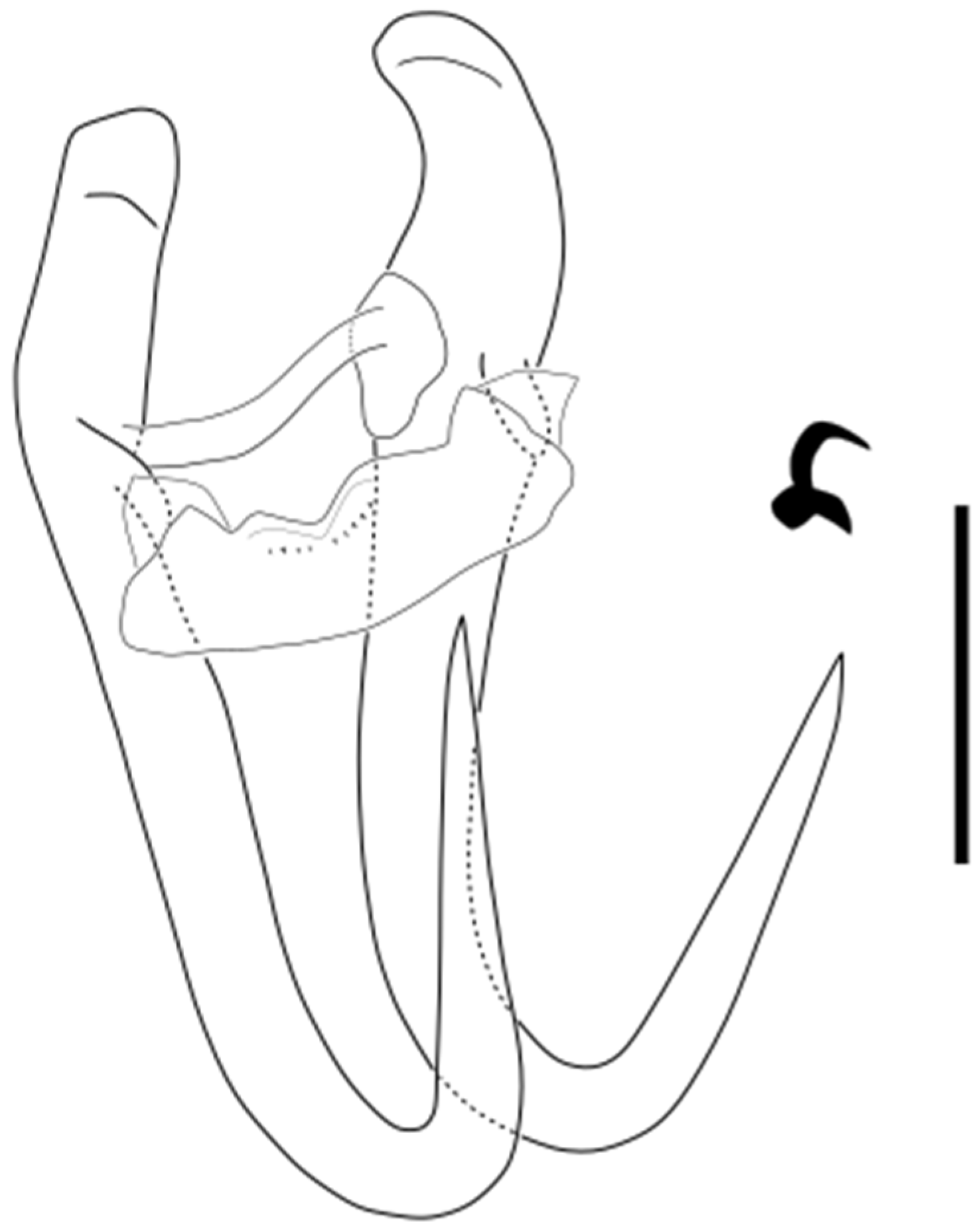
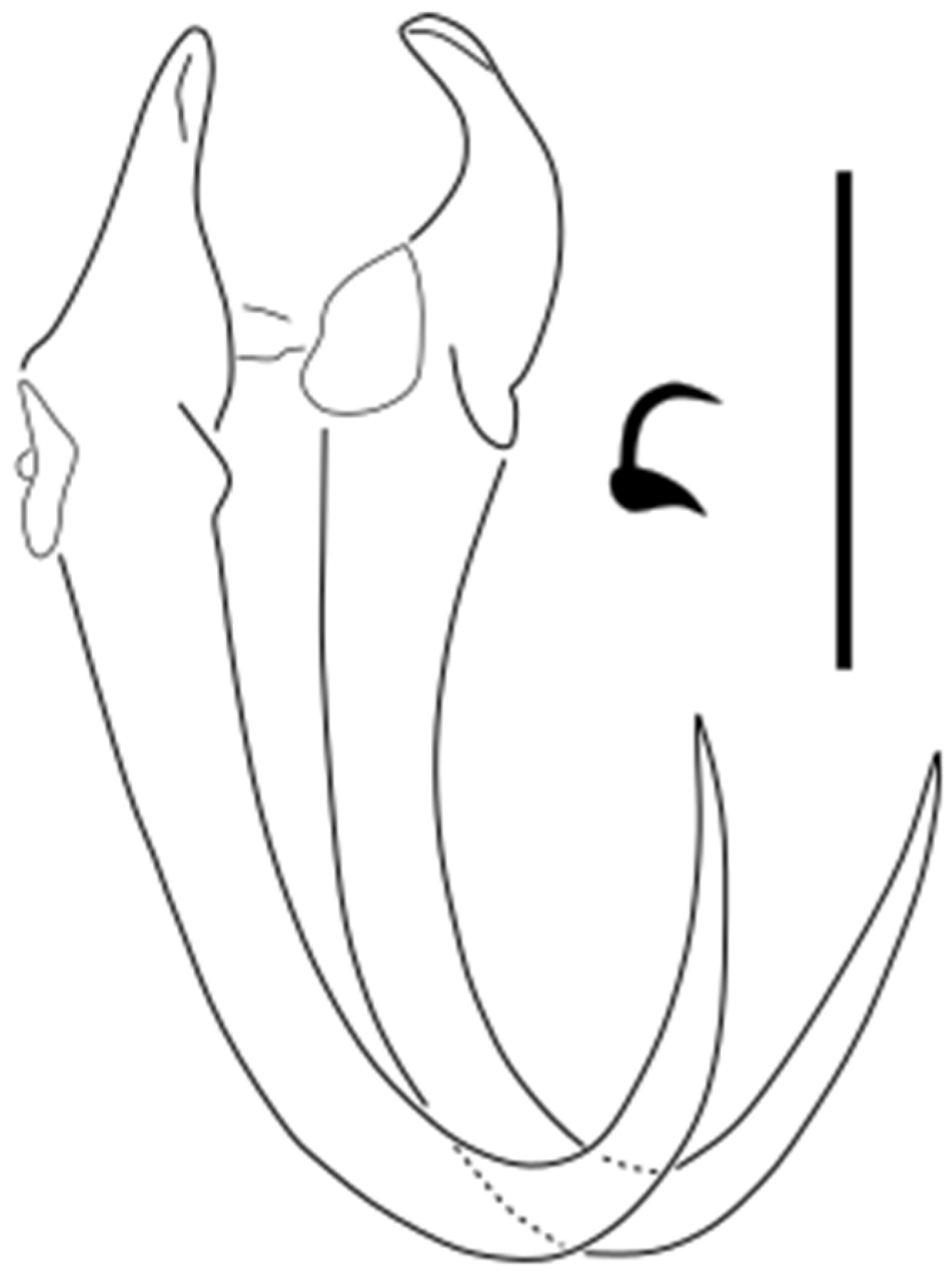
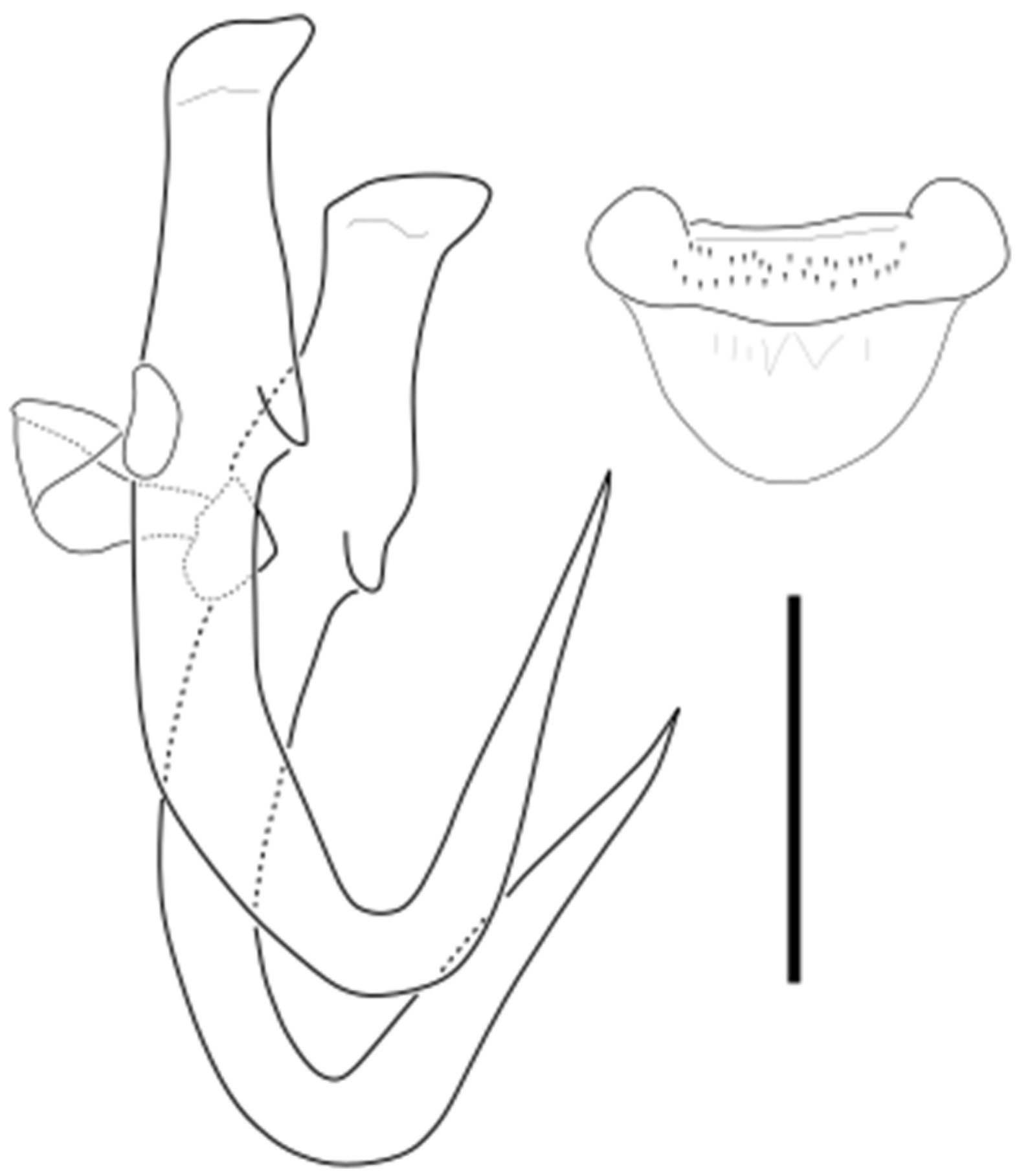
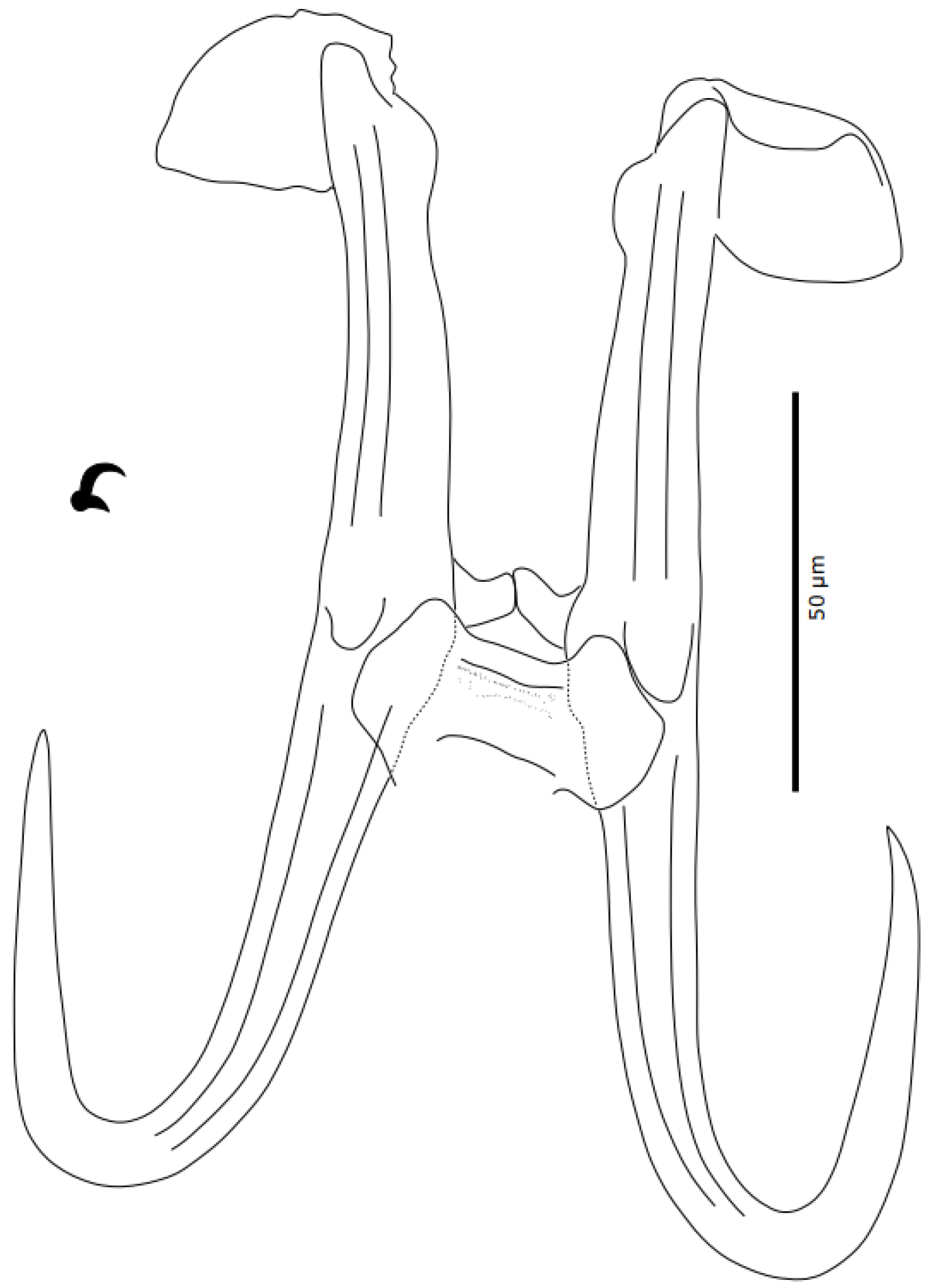

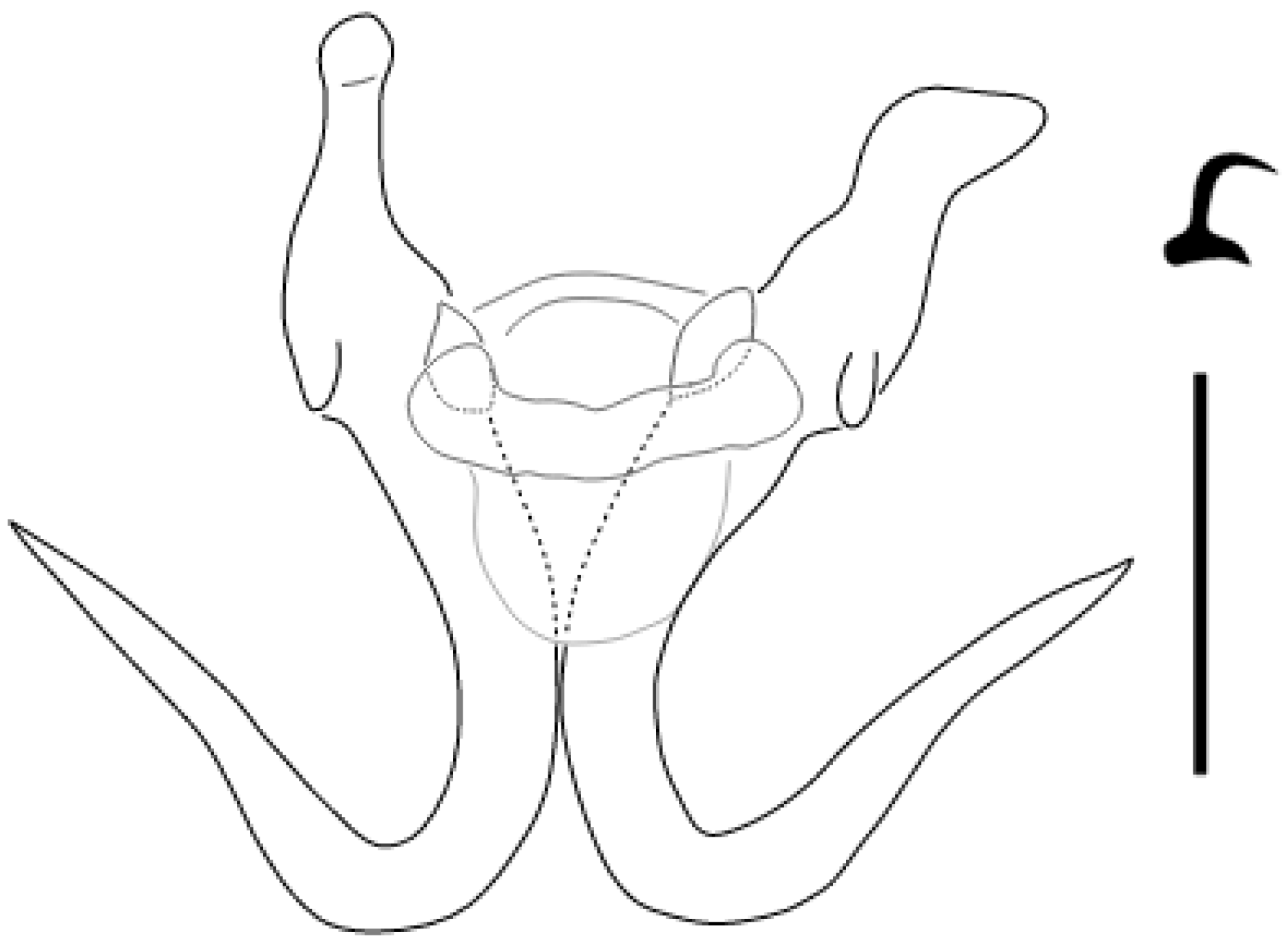
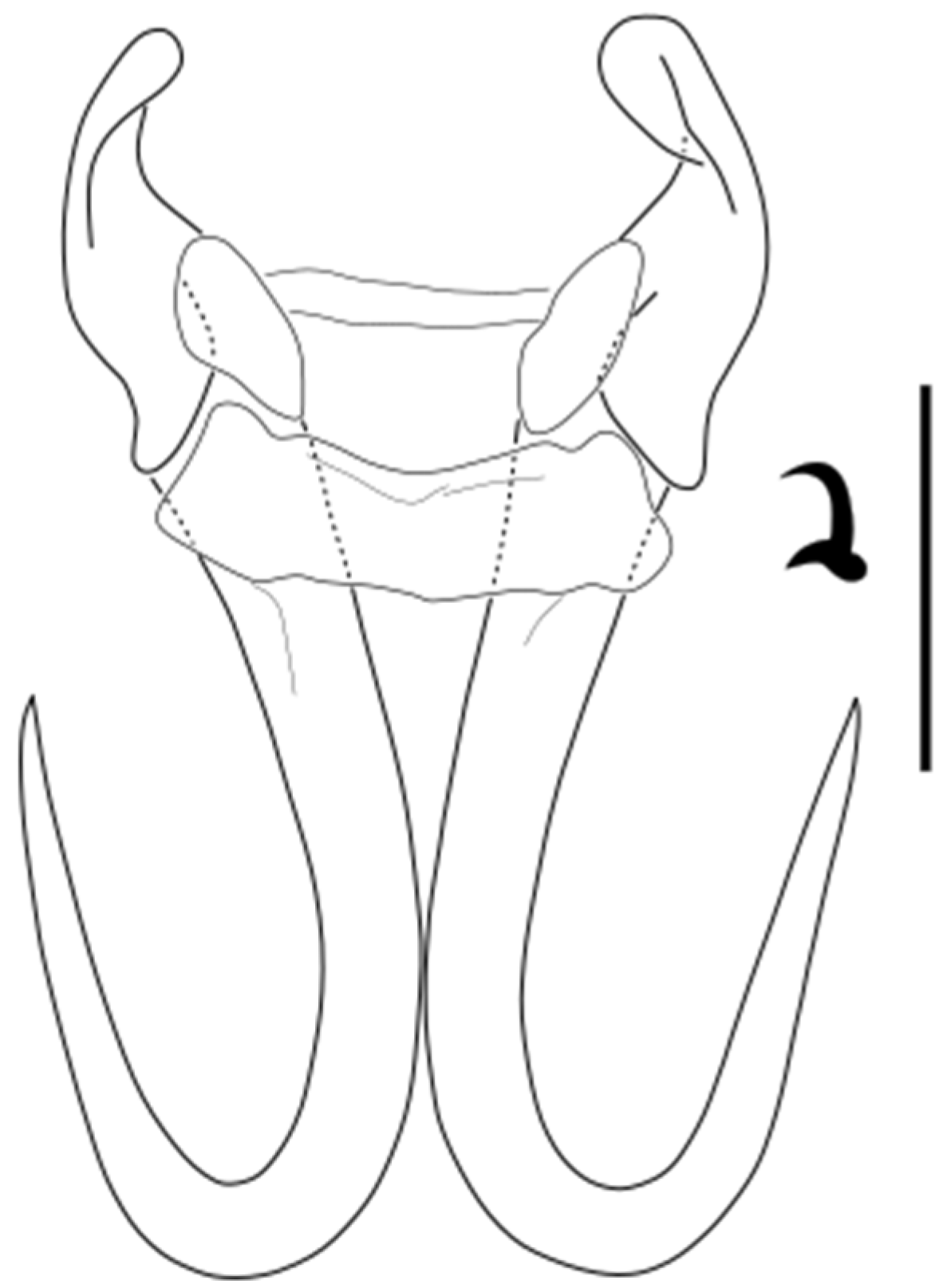


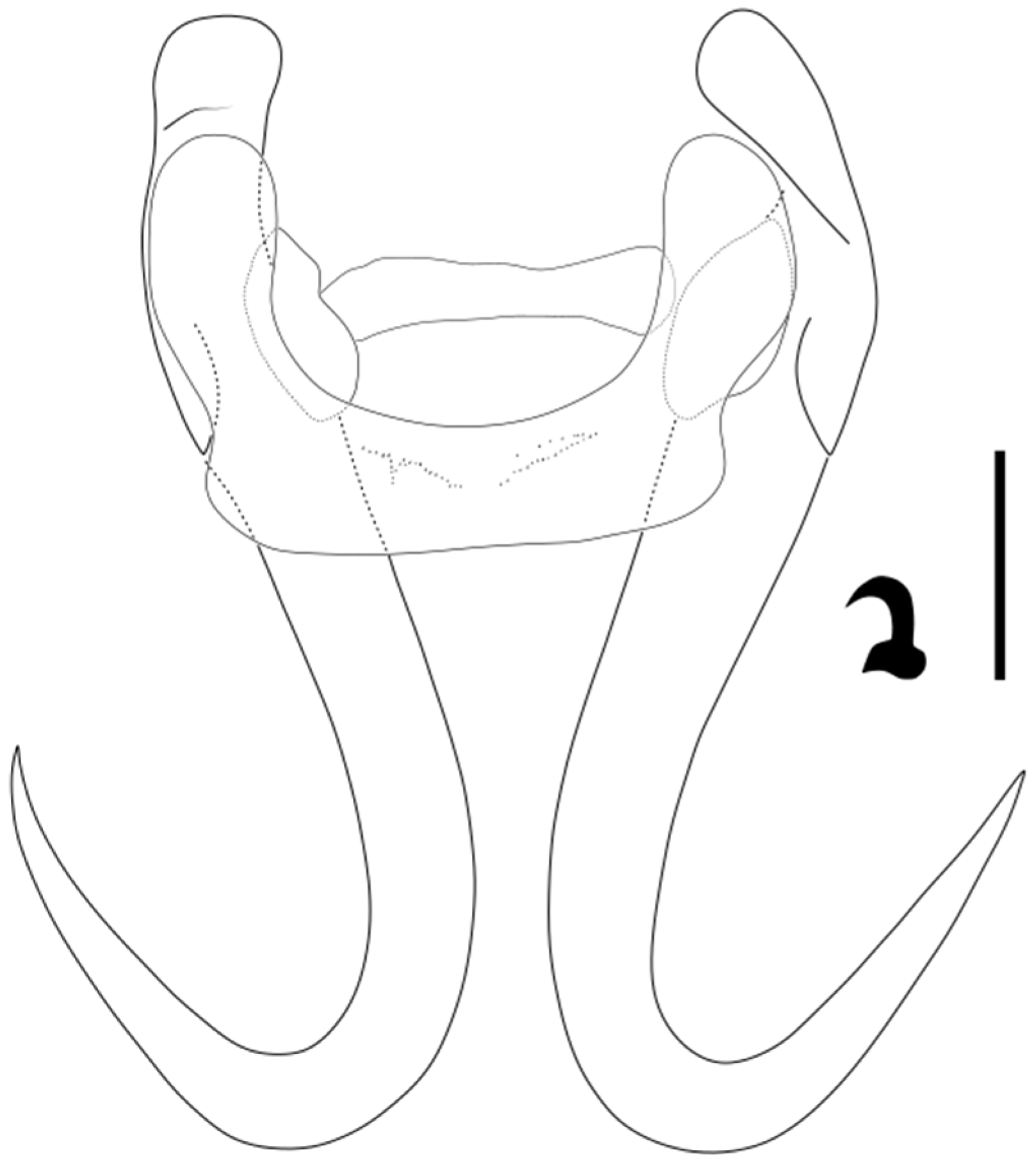
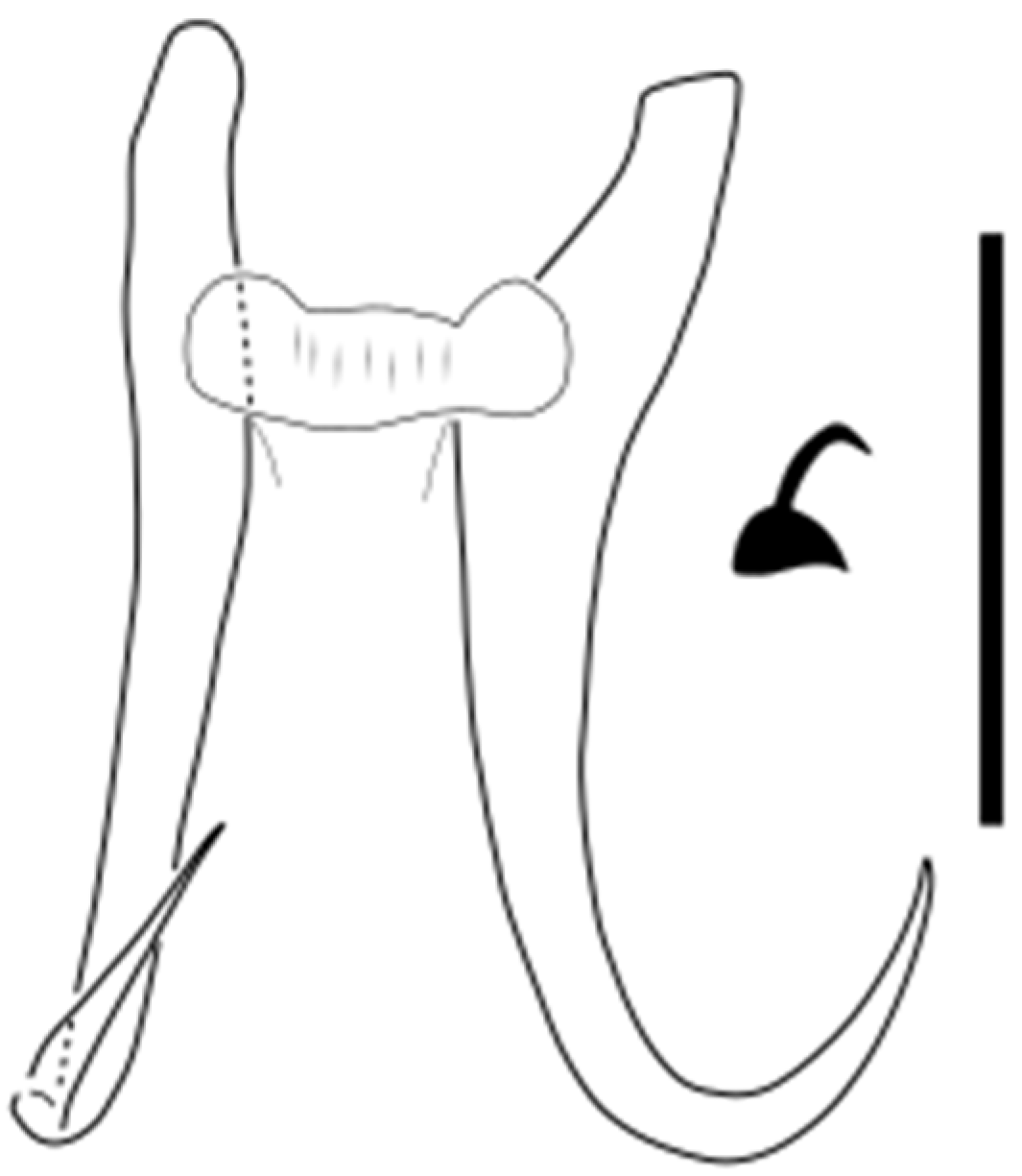

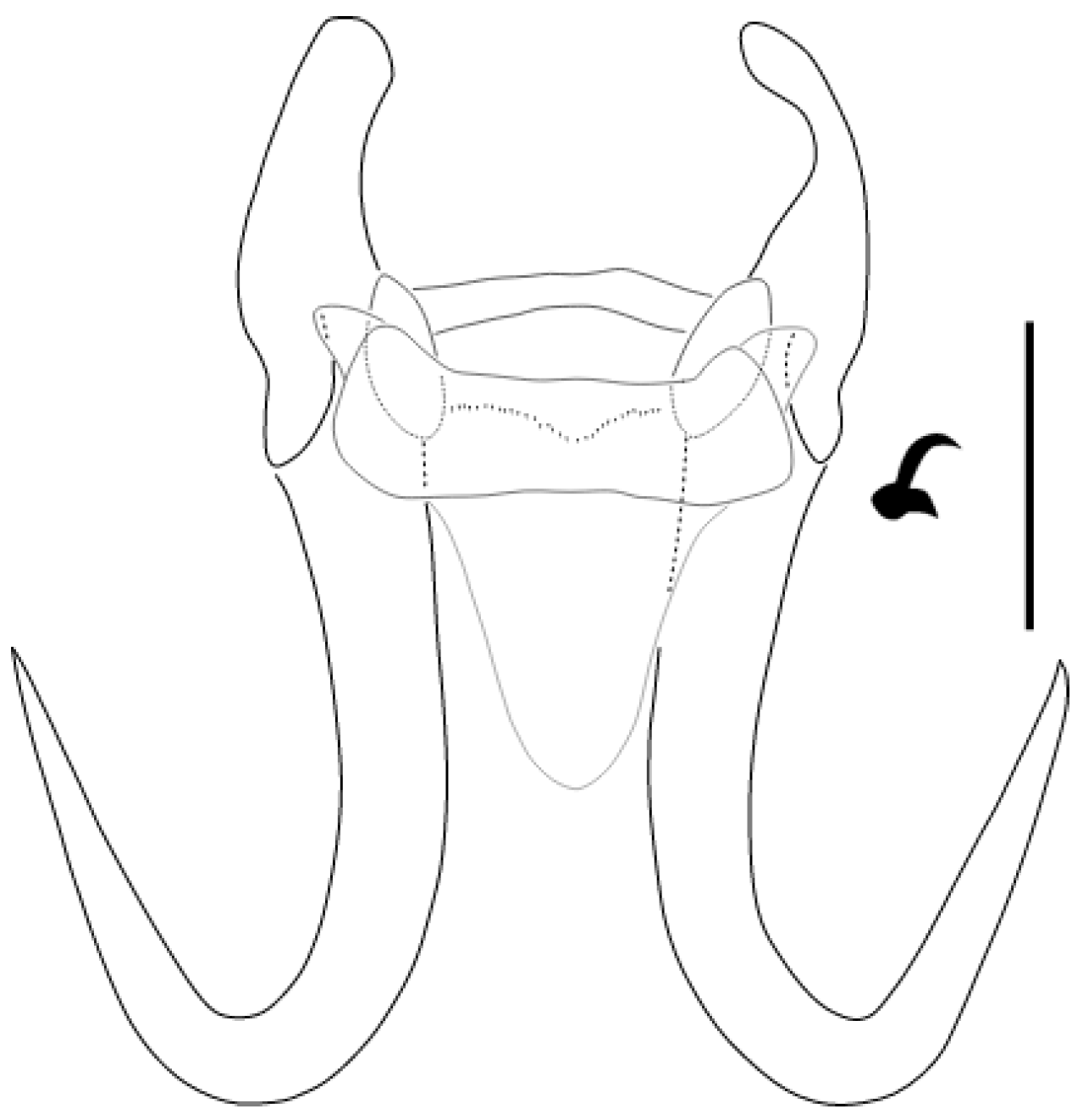



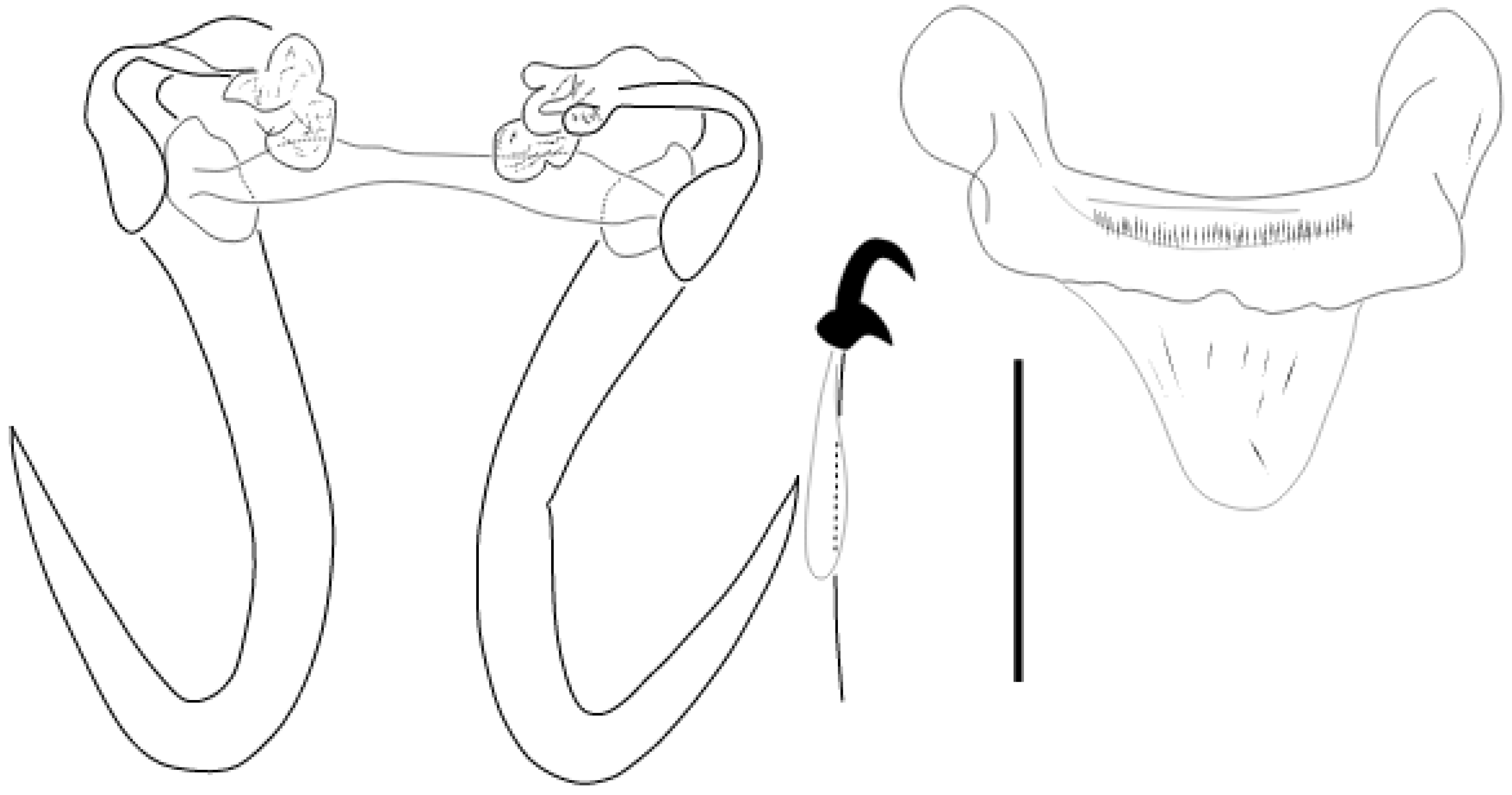



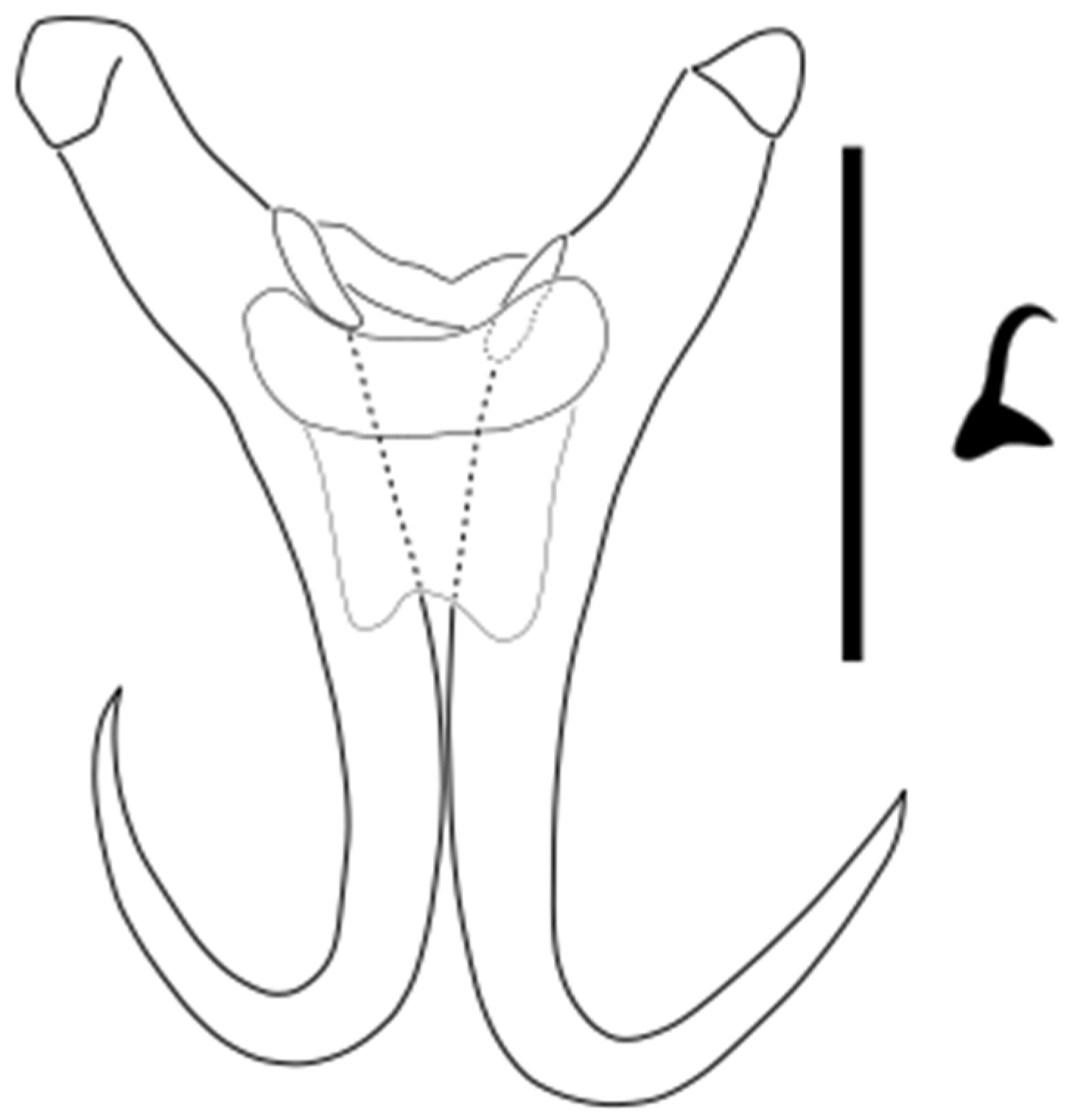
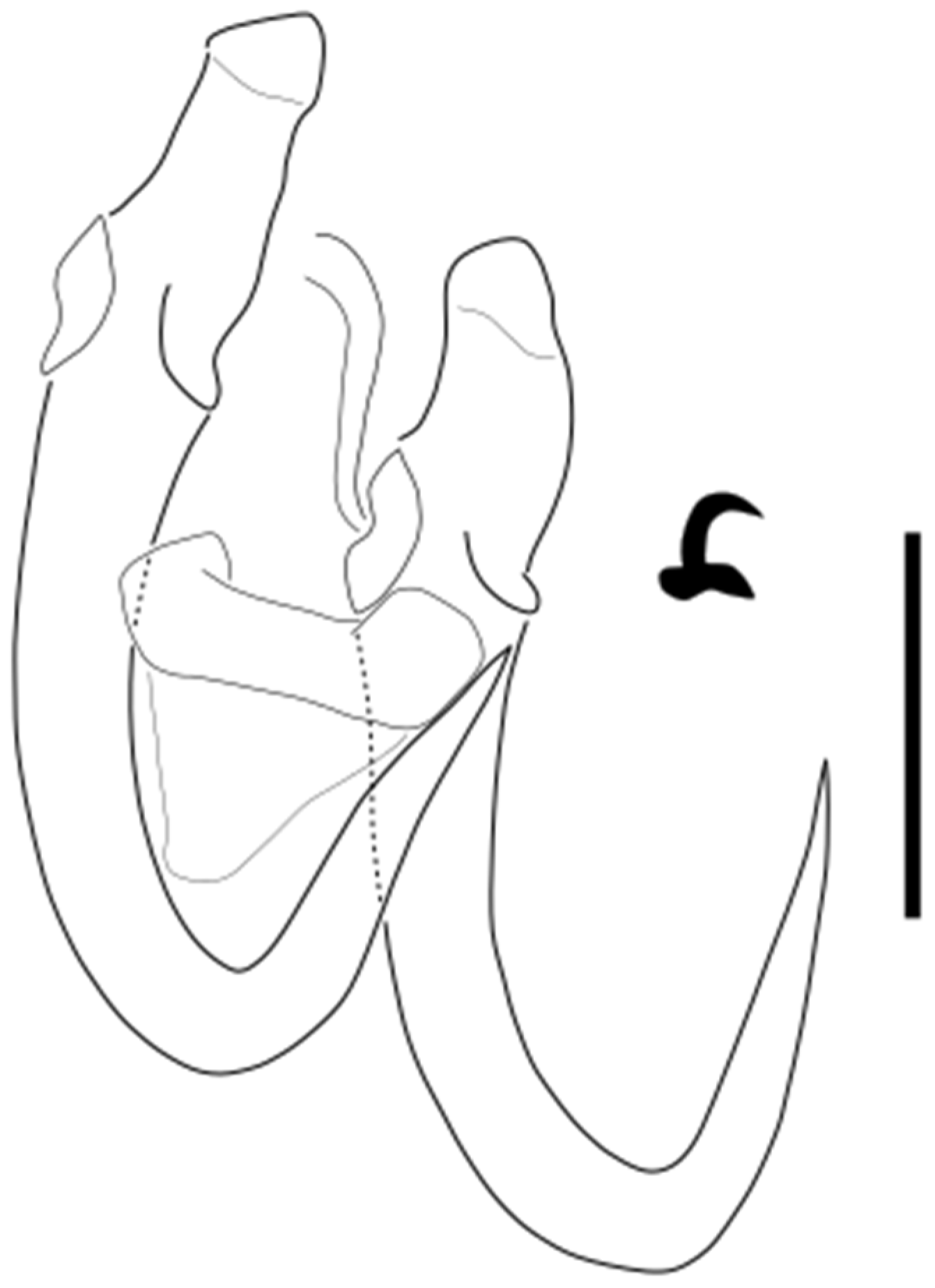
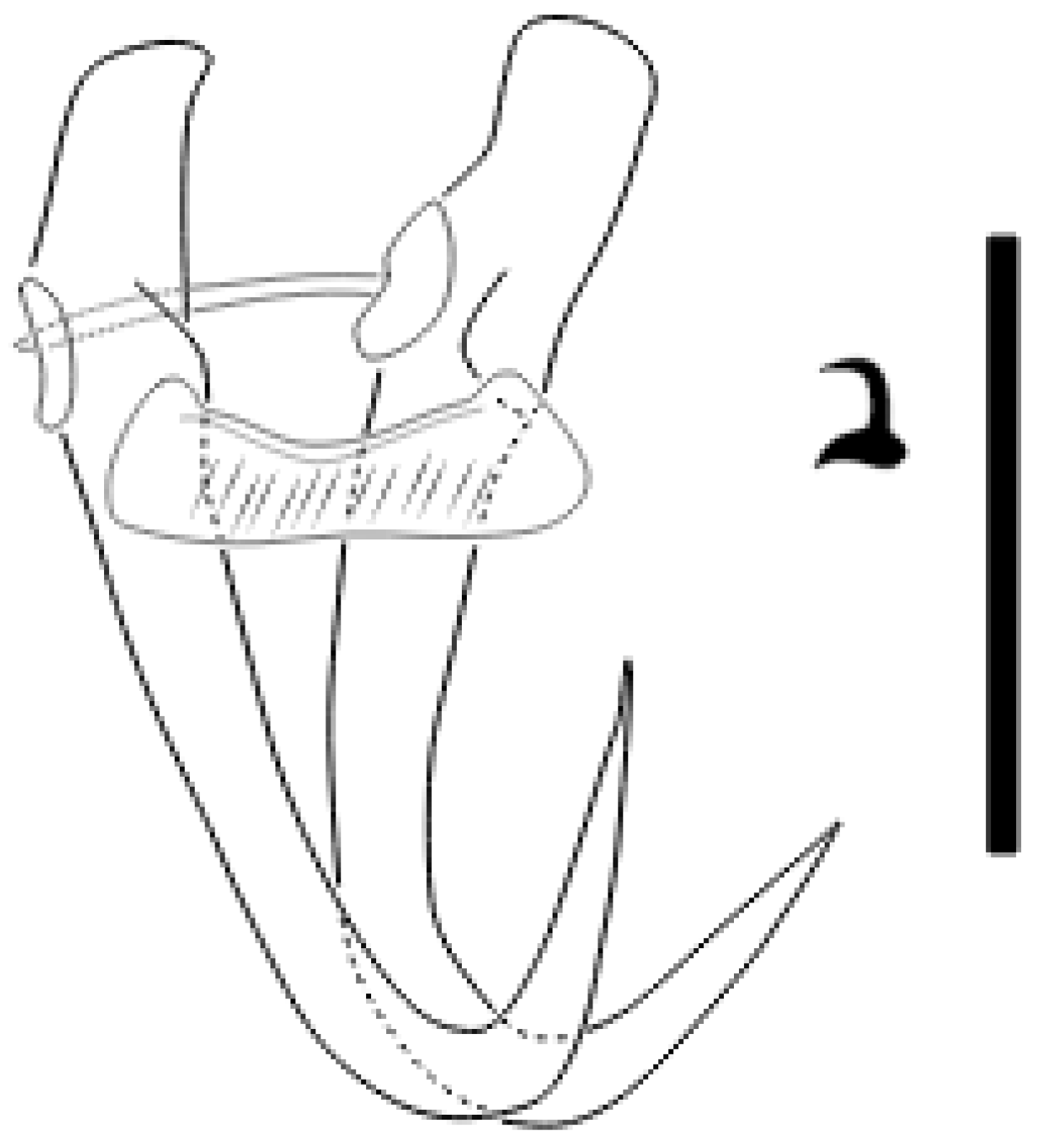
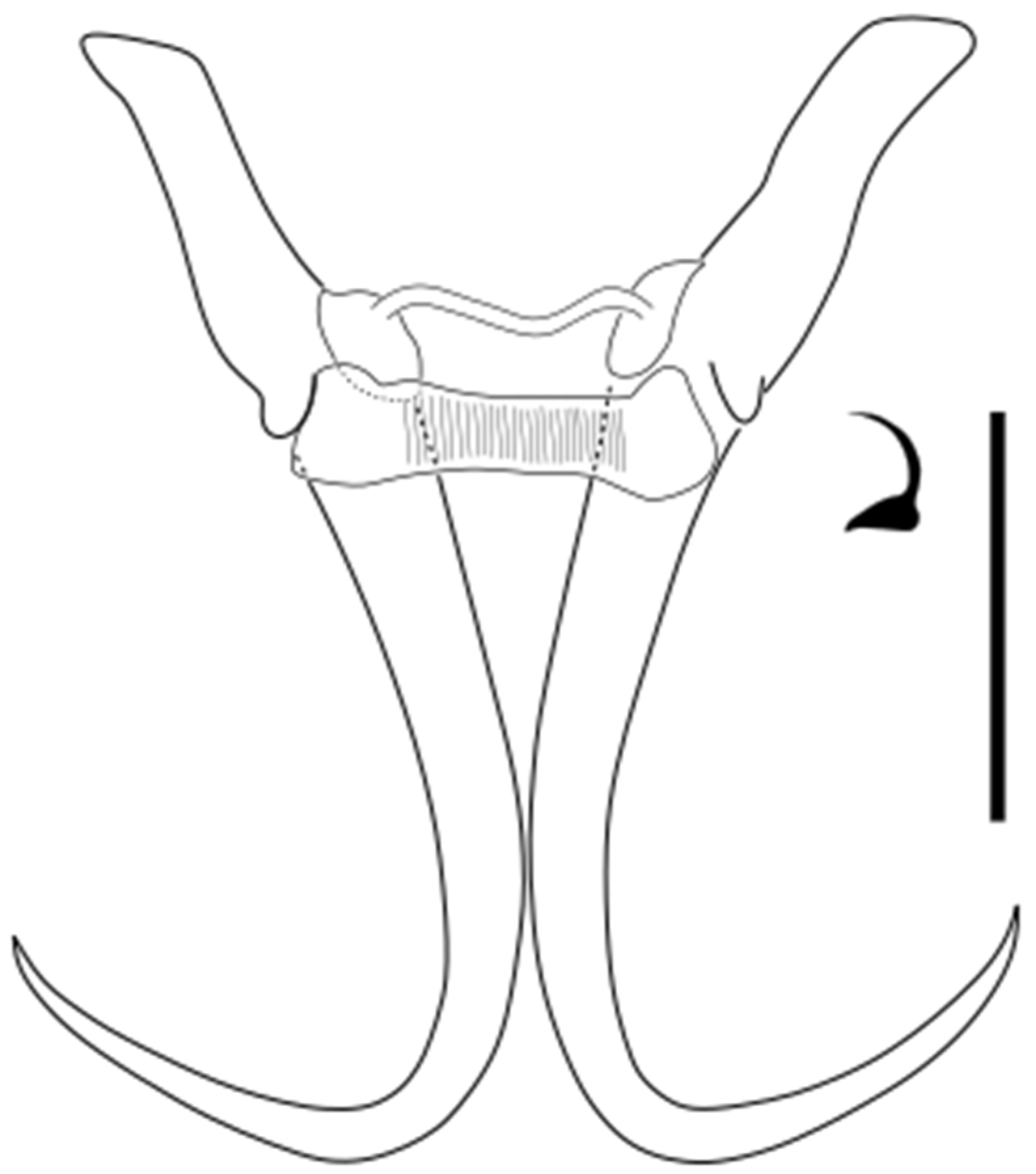
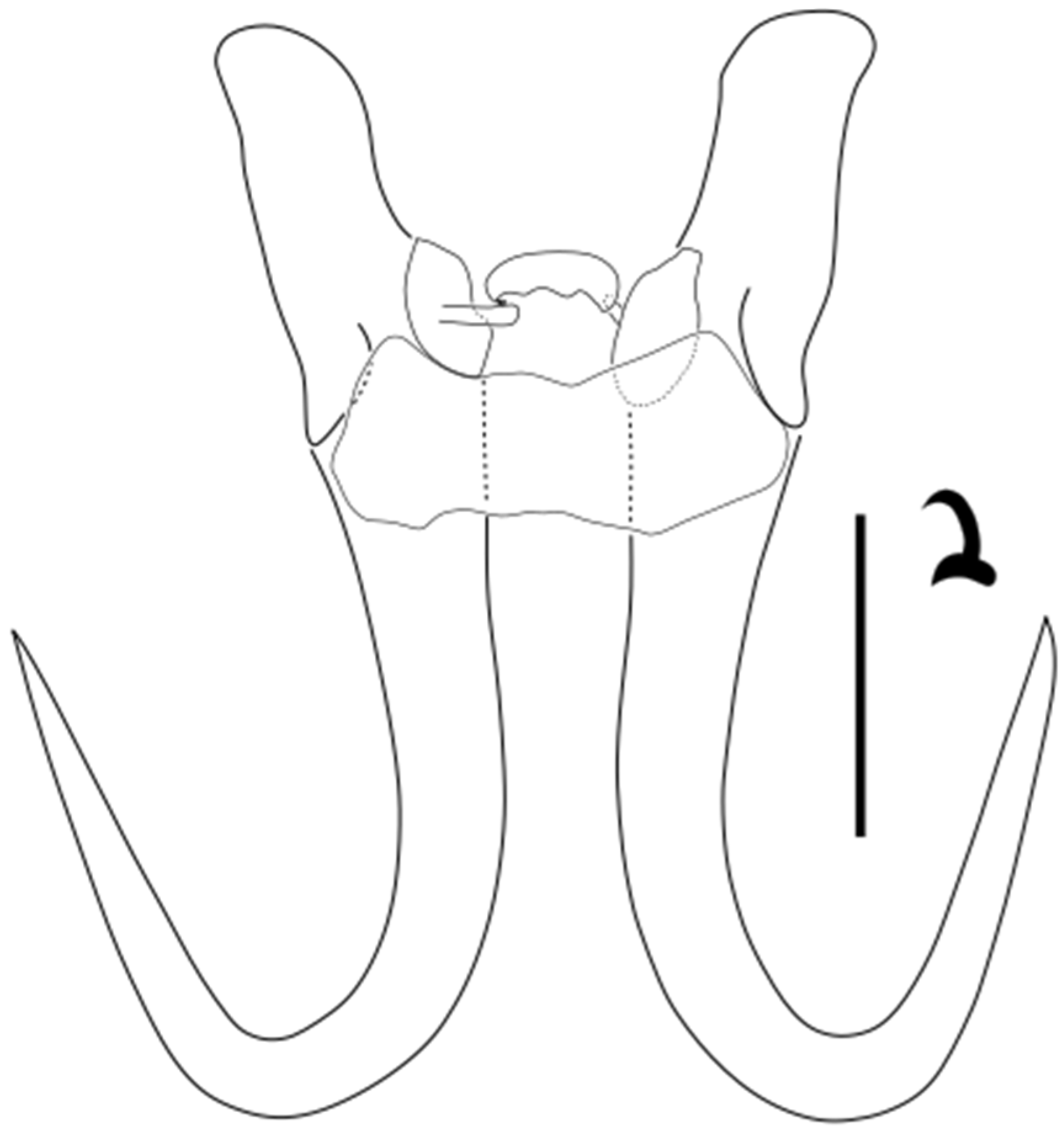


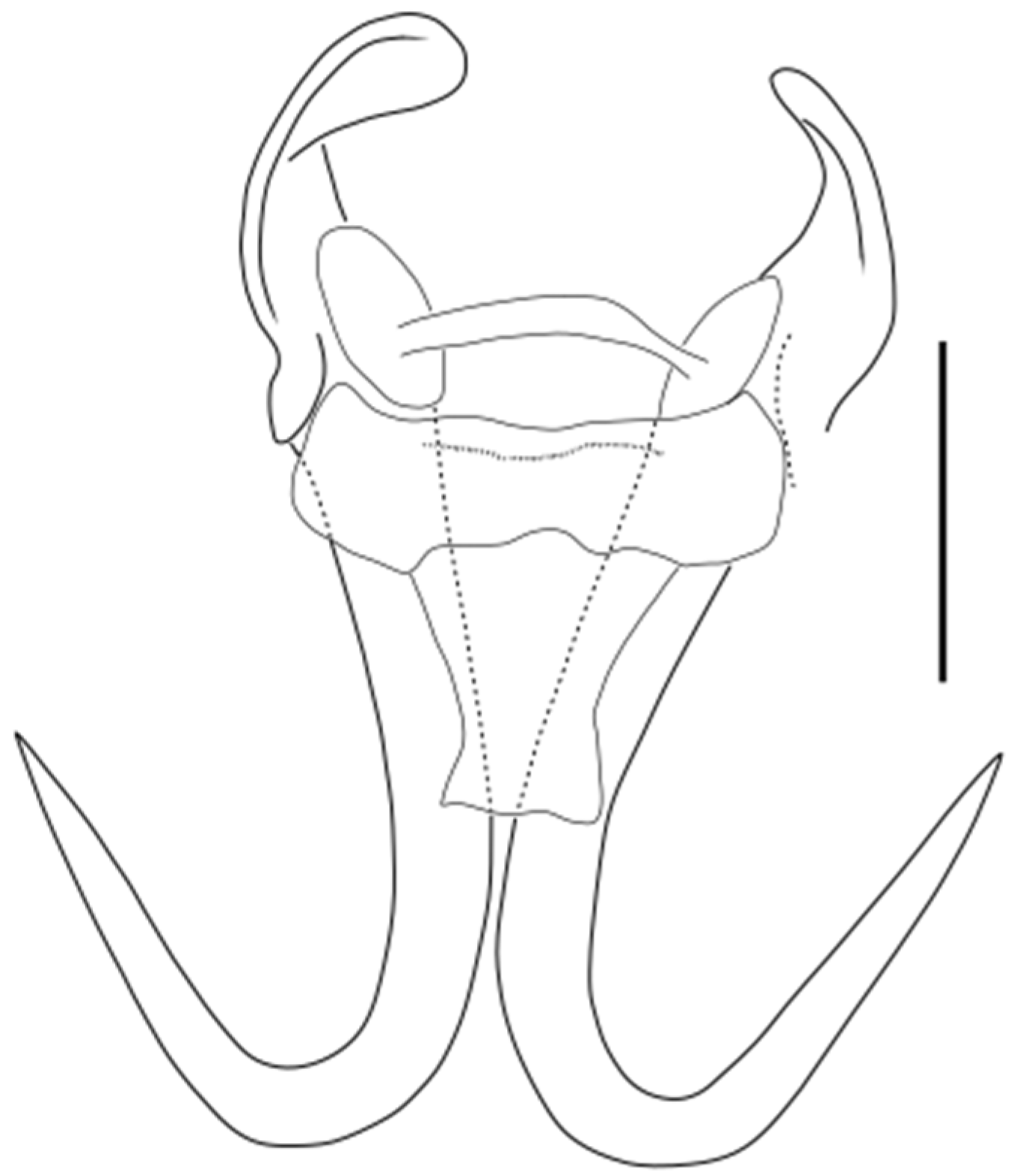

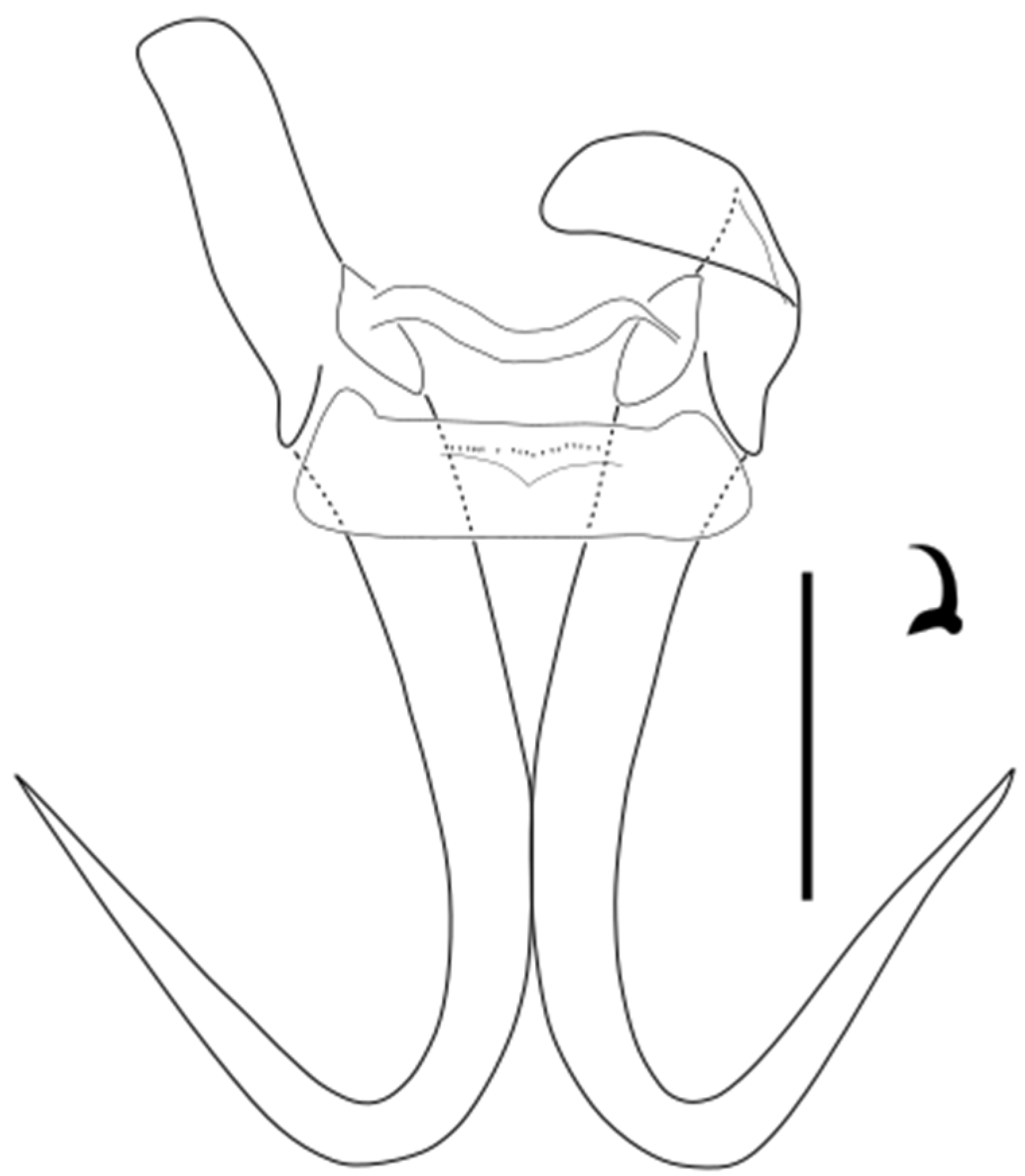
| Source | Malmberg [32] | Ergens et al. [3] | Kakacheva-Avramova [11] | Present Study | |||||||||||||||||
|---|---|---|---|---|---|---|---|---|---|---|---|---|---|---|---|---|---|---|---|---|---|
| Locality | Nämdö (Sweden) | Aneboda (Sweden) | Jämtland (Sweden) | Palaearctic | Nishava River | Nishava River | Stryama River | Sukhoyka River | |||||||||||||
| Range | Mean | n | Range | Mean | n | Range | Mean | n | Range | Range | n | Range | Mean | n | Range | Mean | n | Range | Mean | n | |
| Hamuli: | |||||||||||||||||||||
| TL | 52–63 | 58 | 10 | 56–67 | 60 | 10 | 59–64 | 62 | 10 | 53–70 | 56–64 | 3 | 58–68 | 63.3 | 4 | 60 | - | 1 | 60–63 | 61.5 | 3 |
| S | - | - | - | - | - | - | - | - | - | 37–52 | 44–46 | 3 | 44–47 | 45.5 | 5 | 43–45 | 44 | 2 | 45 | 45 | 3 |
| P | 23–35 | 28 | 10 | 28–29 | 29 | 10 | 31–32 | 32 | 10 | 24–34 | 32–34 | 3 | 28–32 | 31.5 | 5 | 30–31 | 30.5 | 2 | 30–31 | 30.3 | 3 |
| R | 12–20 | 16 | 10 | 16–20 | 18 | 10 | 18–19 | 19 | 10 | 15–23 | - | - | 12–18 | 17.3 | 4 | 18 | - | 1 | 15–19 | 17 | 3 |
| Ventral bar: | |||||||||||||||||||||
| VBl | 23–27 | 25 | 10 | 24–29 | 26 | 10 | 29–31 | 29 | 10 | 22–33 | 30 | 3 | 25–30 | 29 | 5 | 28 | - | 1 | 22–30 | 25.3 | 3 |
| VBw | 8–10 | 9 | 10 | 7–9 | 8 | 10 | 10 | 10 | 10 | 5–9 | 11 | 3 | 6–7 | 6.8 | 5 | 6 | - | 1 | 5–6 | 5.5 | 2 |
| VBml | 9–15 | 12 | 10 | 13–14 | 13 | 10 | 15–16 | 14 | 10 | 11–18 | - | - | - | - | - | - | - | - | - | - | - |
| Dorsal bar: | |||||||||||||||||||||
| DBl | 18–28 | 24 | 10 | 20–21 | 20 | 10 | 23–24 | 24 | 10 | 16–28 | - | - | 15–21 | 17 | 4 | - | - | - | 15 | 15 | 2 |
| DBw | 1–2 | 2 | 10 | 2–3 | 3 | 10 | 2–3 | 2 | 10 | 2–3 | - | - | 2–3 | 2.3 | 4 | - | - | - | 1–2 | 1.3 | 3 |
| Marginal hooks: | |||||||||||||||||||||
| MHl | 5–6 | 5 | 10 | 5 | 5 | 10 | 5 | 5 | 10 | 5–6 | 5–6 | 3 | 5–6 | 5.6 | 5 | 5–6 | 5.5 | 2 | 5 | 5 | 3 |
| MHs | 1–2 | 1 | 10 | 1 | 1 | 10 | 1 | 1 | 10 | - | - | - | 3 | 3 | 5 | 3 | 3 | 2 | 3 | 3 | 3 |
| MHt | 3–4 | 4 | 10 | 4–5 | 4 | 10 | 4–5 | 4 | 10 | - | - | - | 4 | 4 | 4 | 4 | 4 | 2 | - | - | - |
| MHad | - | - | - | - | - | - | - | - | - | - | - | - | 2–3 | 2.6 | 5 | 3 | 3 | 2 | 3 | 3 | 3 |
| Source | Malmberg [32] | Ergens et al. [3] | Present Study | ||
|---|---|---|---|---|---|
| Host | G. cernua | G. cernua | G. schraetser | ||
| Locality | Mälaren | Palaearctic | Danube (Dolno Linevo) | ||
| Range | n | Range | Range | n | |
| Hamuli: | |||||
| TL | 56–62 | 2 | 51–70 | 50 | 2 |
| S | - | - | 39–53 | 38–40 | 2 |
| P | 25–29 | 2 | 21–30 | 18–23 | 2 |
| R | 19–20 | 2 | 17–28 | 13–14 | 2 |
| Ventral bar: | |||||
| VBl | 6–9 | 2 | 5–8 | - | - |
| VBw | 24–16 | 2 | 23–28 | - | - |
| VBml | 13–14 | 2 | 12–17 | - | - |
| Dorsal bar: | |||||
| DBl | 22–24 | 2 | 20–24 | - | - |
| DBw | 1–2 | 2 | 1–3 | - | - |
| Marginal hooks: | |||||
| MHl | 6–7 | 2 | 5–7 | 5–6 | 2 |
| MHs | - | - | - | 2 | 1 |
| MHt | 4 | 2 | - | 5 | 1 |
| MHad | - | - | - | 3 | 1 |
| Source | Ergens et al. [3] | Present Study | |
|---|---|---|---|
| Host | Cobitidae spp. | Cobitis sp. | |
| Locality | Black Sea Basin, Ob River | Byala Reka River | |
| Range | Range | n | |
| Hamuli: | |||
| TL | 41–46 | 50 | 1 |
| S | 26–31 | 33 | 1 |
| P | 24–26 | 29 | 1 |
| R | 16–20 | 24 | 1 |
| Ventral bar: | |||
| VBw | 4–5 | 6 | 1 |
| VBl | 19–23 | 22 | 1 |
| VBml | 9–13 | 9 | 1 |
| Dorsal bar: | |||
| DBl | 2–6 | 6 | 1 |
| DBw | 13–17 | - | - |
| Marginal hooks: | |||
| MHl | 7–8 | - | - |
| MHs | - | - | - |
| MHt | - | - | - |
| MHad | - | - | - |
| Source | Ergens et al. [3] | Present Study | ||||
|---|---|---|---|---|---|---|
| Host | C. carpio | C. carpio | S. erythrophthalmus | |||
| Locality | Palaearctic | Dolni Chiflik Reservoir | Hrabrovski Reservoir | |||
| Range | Range | n | Range | Mean | n | |
| Hamuli: | ||||||
| TL | 88–140 | 129 | 1 | 142–147 | 144.5 | 2 |
| S | 68–84 | 81 | 1 | 80–90 | 85 | 2 |
| P | 34–53 | 54 | 1 | 56 | 56 | 2 |
| R | 56–60 | 55 | 1 | 69–72 | 71.5 | 2 |
| Ventral bar: | ||||||
| VBl | 29–38 | 42 | 1 | 39 | - | 1 |
| VBw | 8–17 | 12 | 1 | 13 | - | 1 |
| VBml | 28–44 | - | 1 | - | - | 1 |
| Dorsal bar: | ||||||
| DBl | 13–21 | 13 | 1 | 15 | - | 1 |
| DBw | 4–7 | 5 | 1 | 5 | - | 1 |
| Marginal hooks: | ||||||
| MHl | 5–7 | - | - | 6 | 6 | 2 |
| MHs | - | - | - | 3–4 | 3.5 | 2 |
| MHt | - | - | - | - | - | - |
| MHad | - | - | - | 3–4 | 3.5 | 2 |
| Source | Ergens [35] | Present Study | ||||||||
|---|---|---|---|---|---|---|---|---|---|---|
| Locality | Rokytná River (Czechia) | Annadere River | Palakariya River | Tundzha River | ||||||
| Range | n | Range | n | Range | Mean | n | Range | Mean | n | |
| Hamuli: | ||||||||||
| TL | 65–68 | 7 | 70 | 1 | 64–65 | 64.5 | 2 | 67 | 67 | 2 |
| S | 48–55 | 7 | 52 | 1 | 44–49 | 47.5 | 2 | 50 | 50 | 2 |
| P | 32–34 | 7 | 34 | 1 | 32 | 32 | 2 | 32 | 32 | 2 |
| R | 19–21 | 7 | 23 | 1 | 17 | 17 | 2 | 19–23 | 21 | 2 |
| Ventral bar: | ||||||||||
| VBl | 7–8 | 7 | 6 | 1 | 7 | 7 | 2 | 6–8 | 7 | 2 |
| VBw | 26–32 | 7 | 32 | 1 | 27–28 | 27.5 | 2 | 30 | - | 1 |
| VBml | 14–18 | 7 | - | - | - | - | - | 23 | - | 1 |
| Dorsal bar: | ||||||||||
| DBl | 18–22 | 7 | - | - | 15 | - | 1 | - | - | - |
| DBw | 2–3 | 7 | 2 | 1 | 2 | - | 1 | - | - | - |
| Marginal hooks: | ||||||||||
| MHl | 7 | 7 | 6 | 1 | 6 | - | 1 | 6 | 6 | 2 |
| MHs | - | - | 3 | 1 | 2 | - | 1 | - | - | - |
| MHt | - | - | - | - | 4 | - | 1 | - | - | - |
| MHad | - | - | 3 | 1 | 4 | - | 1 | 3–5 | 4 | 2 |
| Species | Gyrodactylus fossilis | Gyrodactylus sp. | |||||||||||
|---|---|---|---|---|---|---|---|---|---|---|---|---|---|
| Source | Ergens [36] | Ergens et al. [3] | Present Study | Present Study | |||||||||
| Locality | Iassy (Romania) | Dunajská Streda (Slovakia) | Black Sea Basin | Dragoman Marsh | Danube (Orsoya) | Danube (Silistra) | |||||||
| Range | n | Range | n | Range | Range | Mean | n | Range | n | Range | Mean | n | |
| Hamuli | |||||||||||||
| TL | 48 | 1 | 41–45 | 2 | 41–48 | 42–45 | 43.3 | 3 | 56 | 1 | 52–58 | 55 | 2 |
| S | 30 | 1 | 26–28 | 2 | 26–31 | 27–30 | 28.83 | 3 | 45 | 1 | 40–41 | 40.5 | 2 |
| P | 28 | 1 | 26–28 | 2 | 19–31 | 28–30 | 29.2 | 3 | 21 | 1 | 19–21 | 20 | 2 |
| R | 21 | 1 | 19 | 2 | 19–21 | 16–22 | 20 | 3 | 22 | 1 | 17–23 | 20 | 2 |
| Ventral bar | |||||||||||||
| VBl | 18 | 1 | 16–19 | 2 | 16–21 | - | - | - | - | - | - | - | - |
| VBw | 5 | 1 | 5 | 2 | 4–6 | - | - | - | - | - | - | - | - |
| VBml | - | - | 7 | 2 | 8–12 | - | - | - | - | - | - | - | - |
| Dorsal bar | |||||||||||||
| DBl | - | 1 | 17 | 2 | 14–17 | - | - | - | - | - | - | - | - |
| DBw | - | 1 | 2 | 2 | 2–3 | - | - | - | - | - | - | - | - |
| Marginal hook | |||||||||||||
| MHl | 5–6 | 1+ | 5–6 | 2 | 5–8 | 6 | 6 | 3 | 5 | 1 | 6 | - | 1 |
| MHs | - | - | - | - | - | 2 | 2 | 2 | - | - | - | - | - |
| MHt | - | - | - | - | - | 5 | 5 | 2 | - | - | - | - | - |
| MHad | - | - | - | - | - | 3 | 3 | 2 | - | - | - | - | - |
| Source | Ergens et al. [3] | Present Study | ||||||
|---|---|---|---|---|---|---|---|---|
| Locality | Baltic Sea and Black Sea Basins | Luda Kamchiya River | Sukhoyka River | Varbnishka River | ||||
| Range | Range | n | Range | n | Range | Mean | n | |
| Hamuli: | ||||||||
| TL | 59–79 | 65 | 1 | 66 | 1 | 62–68 | 65.6 | 6 |
| S | 42–56 | 48 | 1 | 47 | 1 | 46–52 | 48.5 | 6 |
| P | 30–37 | 32 | 1 | 31 | 1 | 31–34 | 32.3 | 6 |
| R | 15–26 | 21 | 1 | 26 | 1 | 15–21 | 17.1 | 6 |
| Ventral bar: | ||||||||
| VBw | 26–31 | 27 | 1 | - | - | 27–29 | 28 | 5 |
| VBl | 6–7 | 7 | 1 | - | - | 6–7 | 6.6 | 5 |
| VBml | 15–19 | - | - | - | - | 17 | - | 1 |
| Dorsal bar: | ||||||||
| DBl | 25–35 | 20 | 1 | - | - | 15–20 | 18.5 | 4 |
| DBw | 2–3 | 2 | 1 | 2 | 1 | 2 | 2 | 4 |
| Marginal hooks: | ||||||||
| MHl | 6–7 | 7 | 1 | - | - | 6 | 6 | 5 |
| MHs | - | 4 | 1 | - | - | 2–3 | 2.4 | 5 |
| MHt | - | - | - | - | - | - | - | - |
| MHad | - | 4 | 1 | - | - | 3–4 | 3.4 | 5 |
| Source | Schulman [38] | Ergens et al. [3] | Kakacheva-Avramova [11] | Present Study | |||||||||||||
|---|---|---|---|---|---|---|---|---|---|---|---|---|---|---|---|---|---|
| Locality | Neman River, Rezka Lake, Drevyata Lake | Palaearctic | Western Stara Planina | Annadere River | Eleshnitsa River | Kotleshnitsa River | Varbnishka River | Zlatina River | |||||||||
| Range | Range | Range | n | Range | n | Range | Mean | n | Range | Mean | n | Range | n | Range | Mean | n | |
| Hamuli: | |||||||||||||||||
| TL | 46–61 | 47–60 | 48–72 | 23 | 60 | 1 | 56–57 | 56.5 | 2 | 55–60 | 57.2 | 9 | 55 | 1 | 55 | - | 1 |
| S | 36–40 | 34–44 | 34–52 | 23 | 44 | 1 | 40–41 | 40.5 | 2 | 42–45 | 43.8 | 9 | 44 | 1 | 37–41 | 39 | 2 |
| P | 16–24 | 22–28 | 21–34 | 23 | 31 | 1 | 27–28 | 27.5 | 2 | 26–30 | 28.4 | 9 | 26 | 1 | 28–29 | 28.5 | 2 |
| R | 9–12 | 13–19 | 15–18 | 23 | 19 | 1 | 15–17 | 16 | 2 | 13–21 | 15.9 | 9 | 13 | 1 | 16–18 | 17 | 2 |
| Ventral bar: | |||||||||||||||||
| VBl | 21–24 | 21–27 | 16–28 | 23 | 27 | 1 | 23–25 | 24 | 2 | 24–31 | 27 | 9 | 26 | 1 | 25 | - | 1 |
| VBw | 5–6 | 5–7 | 5–6 | 23 | 6 | 1 | 7 | 7 | 2 | 5–7 | 6.3 | 9 | 5 | 1 | 6 | - | 1 |
| VBml | - | 11–15 | - | - | - | - | 14 | - | 1 | 13 | - | 1 | - | - | - | - | - |
| Dorsal bar: | |||||||||||||||||
| DBl | 18–20 | 15–20 | 14–20 | 23 | 15 | 1 | 15 | - | 1 | 19–23 | 21.3 | 7 | 19 | 1 | - | - | - |
| DBw | 2 | 2–3 | 2–3 | 23 | 2 | 1 | 2 | - | 1 | 2–3 | 2.3 | 8 | 2 | 1 | 2–3 | 2.5 | 2 |
| Marginal hooks: | |||||||||||||||||
| MHl | - | 5–7 | 4–6 | 23 | - | - | 6 | 6 | 2 | 6–7 | 6.6 | 9 | 6 | 1 | 6 | 6 | 2 |
| MHs | - | - | - | - | - | - | 2 | - | 1 | 2 | 2 | 7 | - | - | 2 | - | 1 |
| MHt | - | - | - | - | - | - | 4–5 | 4.5 | 2 | 4–5 | 4.6 | 7 | - | - | 4–5 | 4.5 | 2 |
| MHad | - | - | - | - | - | - | 3 | 3 | 2 | 3–4 | 3.4 | 7 | - | - | 3 | 3 | 2 |
| Species | Gyrodactylus wageneri scardinii | Gyrodactylus gracilihamatus | ||||
|---|---|---|---|---|---|---|
| Host | A. alburnus | Various Cyprinids | S. cephalus | |||
| Source | Malmberg [32] | Ergens et al. [3] | Present Study | |||
| Locality | Nämdö, Sweden | Basins of Black, Baltic and Caspian Seas | Luda Kamchiya River | Shiposhnitsa River | ||
| Mean | Range | Range | n | Range | n | |
| Hamuli: | ||||||
| TL | 63 | 57–80 | 66 | 1 | 59 | 1 |
| S | - | 43–49 | 47 | 1 | 44 | 1 |
| P | 29 | 24–31 | 28 | 1 | 28 | 1 |
| R | 19 | 18–26 | 18 | 1 | 18 | 1 |
| Ventral bar: | ||||||
| VBl | 10 | 6–8 | 7 | 1 | 6 | 1 |
| VBw | 24 | 23–29 | 27 | 1 | 22 | 1 |
| VBml | 15 | 13–18 | - | 1 | - | - |
| Dorsal bar: | ||||||
| DBl | 28 | 17–25 | 17 | - | - | - |
| DBw | 2 | 1–2 | 2 | 1 | 1 | 1 |
| Marginal hooks: | ||||||
| MHl | 6 | 5–7 | - | - | 6 | 1 |
| MHs | - | - | - | - | - | - |
| MHt | - | - | - | - | - | - |
| MHad | - | - | - | - | - | 1 |
| Source | Malmberg [1] | Ergens et al. [3] | Present Study | ||||||||||
|---|---|---|---|---|---|---|---|---|---|---|---|---|---|
| Host | C. carpio | Cyprinids | B. petenyi | V. melanops | C. carpio | C. carpio | |||||||
| Locality | Bokelholm Fish-Culture Farm, West Germany | “Europe and Asia” | Varbnishka River | Tundzha River | Blagoevgrad Fish Farm | Varbnishka River | |||||||
| Range | Mean | n | Range | Range | n | Range | n | Range | n | Range | Mean | n | |
| Hamuli: | |||||||||||||
| TL | 87–97 | 91.7 | 10 | 71–112 | 89 | 1 | 101 | 1 | 96 | 1 | 100–103 | 101.3 | 2 |
| S | 62–71 | 65.8 | 10 | 51–84 | 65 | 1 | 72 | 1 | 71 | 1 | 73–75 | 74 | 2 |
| P | 39–43 | 40.9 | 10 | 27–52 | 43 | 1 | 44 | 1 | 43 | 1 | 45–51 | 48.3 | 2 |
| R | 26–31 | 29 | 10 | 16–35 | - | - | 29 | 1 | 25 | 1 | 30–31 | 30.3 | 2 |
| Ventral bar: | |||||||||||||
| VBw | 39–41 | 40.6 | 10 | 33–50 | 45 | 1 | 46 | 1 | 47 | 1 | 42–44 | 43 | 2 |
| VBl | 8–13 | 10.4 | 10 | 8–14 | 10 | 1 | 11 | 1 | 10 | 1 | 12–15 | 13.5 | 2 |
| VBml | 24–28 | 25.8 | 10 | 18–40 | - | - | - | - | - | - | - | - | - |
| Dorsal bar: | |||||||||||||
| DBl | 34–50 | 42.7 | 10 | 20–48 | 21 | 1 | 31 | 1 | 33 | 1 | 29–32 | 30.5 | 2 |
| DBw | 2–4 | 3.2 | 10 | 2–5 | 4 | 1 | 5 | 1 | 4 | 1 | 3–5 | 4 | 2 |
| Marginal hooks: | |||||||||||||
| MHl | 8–9 | 8.7 | 10 | 8–10 | 8 | 1 | 9 | 1 | 10 | 1 | 9 | 9 | 2 |
| MHs | - | - | - | - | 4 | 1 | 4 | 1 | 4 | 1 | 4 | 4 | 2 |
| MHt | - | - | - | - | - | - | - | - | 7 | 1 | 6 | 6 | 2 |
| MHad | - | - | - | - | 4 | 1 | 5 | 1 | 5 | 1 | 4–5 | 4.5 | 2 |
| Source | Malmberg [32] | Ergens et al. [3] | Present Study | |||
|---|---|---|---|---|---|---|
| Locality | Fiolenbäcken, Aneboda (Sweden) | Palaearctic | Nishava River | |||
| Range | n | Range | Range | Mean | n | |
| Hamuli: | ||||||
| TL | 36 | 1 | 33–43 | 37–44 | 39.8 | 3 |
| S | - | 1 | 27–34 | 27–35 | 31.5 | 3 |
| P | 18 | 1 | 15–18 | 12–15 | 13.8 | 3 |
| R | - | 1 | 10–16 | 11–12 | 11.8 | 3 |
| Ventral bar: | ||||||
| VBw | - | 1 | 4–6 | 4 | - | 1 |
| VBl | - | 1 | 9–15 | - | - | - |
| VBml | - | 1 | 9–16 | - | - | - |
| Dorsal bar: | ||||||
| DBl | - | 1 | 7–9 | - | - | - |
| DBw | - | 1 | 1 | - | - | - |
| Marginal hooks: | ||||||
| MHl | 6 | 1 | 5–6 | 5–6 | 5.3 | 3 |
| MHs | - | - | - | 2–3 | 2.7 | 3 |
| MHt | - | - | - | - | - | - |
| MHad | - | - | - | 2–4 | 2.5 | 3 |
| Source | Ergens et al. [3] | Present Study | ||
|---|---|---|---|---|
| Host | C. taenia | Cobitis sp. | ||
| Locality | Volga, Danube, Oder, Elbe River Estuaries | Byala Reka River | ||
| Range | Range | Mean | n | |
| Hamuli: | ||||
| TL | 50–57 | 47–55 | 50 | 3 |
| S | 40–44 | 38–43 | 39.7 | 3 |
| P | 22–28 | 25–30 | 26.3 | 3 |
| R | 15–19 | 16–18 | 16.8 | 3 |
| Ventral bar: | ||||
| VBl | 6–7 | 6–7 | 6.5 | 2 |
| VBw | 13–19 | 13–14 | 13.5 | 2 |
| VBml | 12–14 | 10–15 | 12.5 | 2 |
| Dorsal bar: | ||||
| DBl | 9–14 | 10–12 | 11 | 2 |
| DBw | 1–2 | 1–2 | 1.7 | 3 |
| Marginal hooks: | ||||
| MHl | 7 | 6–7 | 6.3 | 3 |
| MHs | - | 1 | 1 | 3 |
| MHt | - | 5 | 5 | 3 |
| MHad | - | 2–3 | 2.3 | 3 |
| Source | Ergens et al. [3] | Present Study | ||||||||
|---|---|---|---|---|---|---|---|---|---|---|
| Gyrodactylus luciopercae | Gyrodactylus longiradix sensu Kakacheva-Avramova [14] | |||||||||
| Host | G. cernua, P. fluviatilis, S. lucioperca | S. lucioperca | G. cernua | |||||||
| Locality | Basins of Caspian, Black and Baltic Seas | Danube (Svishtov) | Danube (Dolni Tsibar) | Danube (Dunavets) | ||||||
| Range | Range | Mean | n | Range | Mean | n | Range | Mean | n | |
| Hamuli: | ||||||||||
| TL | 64–80 | 60–70 | 66.5 | 23 | 65–79 | 73.3 | 6 | 60–67 | 64.2 | 3 |
| S | 45–51 | 45–50 | 47.7 | 23 | 45–57 | 53.8 | 6 | 47–51 | 48.6 | 3 |
| P | 27–31 | 24–31 | 28.4 | 23 | 28–36 | 32.4 | 6 | 25–29 | 26.5 | 3 |
| R | 22–28 | 17–26 | 22.3 | 20 | 20–31 | 25 | 6 | 20–24 | 22.5 | 3 |
| Ventral bar: | ||||||||||
| VBl | 5–8 | 6–8 | 6.3 | 21 | 7 | 7 | 4 | 5–7 | 5.7 | 3 |
| VBw | 26–33 | 24–32 | 27.5 | 17 | 24–25 | 24.5 | 2 | 23–24 | 23.5 | 2 |
| VBml | 14–19 | 13–16 | 14.8 | 9 | 15 | - | 1 | - | - | - |
| Dorsal bar: | ||||||||||
| DBl | 21–29 | 16–26 | 22.2 | 12 | - | - | - | 2 | 2 | 2 |
| DBw | 1–3 | 1–2 | 1.8 | 18 | 1–3 | 2.1 | 5 | 22–25 | 23.5 | 2 |
| Marginal hooks: | ||||||||||
| MHl | 6–7 | 6–7 | 6.7 | 20 | 6–7 | 6.8 | 6 | 6–7 | 6.5 | 2 |
| MHs | - | 2–3 | 2.2 | 17 | 2–3 | 2.4 | 5 | 2 | 2 | 2 |
| MHt | - | 4–6 | 4.7 | 15 | 3–5 | 4.6 | 5 | 5 | 5 | 2 |
| MHad | - | 3–5 | 3.9 | 17 | 3–4 | 3.8 | 5 | 3–4 | 3.5 | 2 |
| Source | Ergens et al. [3] | Kakacheva-Avramova & Menkova [18] | Present Study | |||
|---|---|---|---|---|---|---|
| Locality | Danube River, Oder River | Zheleznitsa River | Zheleznitsa River | |||
| Range | Range | n | Range | Mean | n | |
| Hamuli: | ||||||
| TL | 74–85 | 72 | 1 | 71–78 | 75.3 | 12 |
| S | 54–60 | 54 | 1 | 52–59 | 54.7 | 12 |
| P | 30–48 | 33 | 1 | 35–39 | 36.3 | 12 |
| R | 23–29 | 24 | 1 | 18–26 | 23.2 | 12 |
| Ventral bar: | ||||||
| VBl | 7–11 | 7 | 1 | 8–11 | 9.3 | 12 |
| VBw | 29–36 | 28 | 1 | 31–39 | 31.3 | 12 |
| VBml | 18–25 | - | - | 13–20 | 16.5 | 2 |
| Dorsal bar: | ||||||
| DBl | 20–28 | 21 | 1 | 15–26 | 20.9 | 8 |
| DBw | 2–4 | 2 | 1 | 3–6 | 4.2 | 12 |
| Marginal hooks: | ||||||
| MHl | 5–7 | 6 | 1 | 5–6 | 5.9 | 9 |
| MHs | - | - | - | 2 | 2 | 8 |
| MHt | - | - | - | 3–6 | 4.6 | 7 |
| MHad | - | - | - | 3–4 | 3.2 | 6 |
| Source | Malmberg [32] | Ergens et al. [3] | Kakacheva- Avramova [11] | Present Study | |||||||
|---|---|---|---|---|---|---|---|---|---|---|---|
| Host | P. phoxinus | P. phoxinus, R. percnura, R. rutilus | P. phoxinus | ||||||||
| Locality | Nämdö (Sweden) | Svartbäken, Jämtland (Sweden) | Palaearctic | Nishava River | Nishava River | ||||||
| Range | Mean | n | Range | Mean | n | Range | Range | n | Range | n | |
| Hamuli: | |||||||||||
| TL | 68–75 | 71 | 6 | 71–78 | 75 | 6 | 68–96 | 74–84 | 7 | 80 | 1 |
| S | - | - | - | - | - | - | 40–62 | 54–66 | 7 | 56 | 1 |
| P | 29–36 | 33 | 6 | 35–36 | 35 | 6 | 26–40 | 32–40 | 7 | 35 | 1 |
| R | 23–26 | 24 | 6 | 20–24 | 23 | 6 | 22–33 | - | - | 27 | 1 |
| Ventral bar: | |||||||||||
| VBl | 6–12 | 10 | 6 | 11–15 | 12 | 6 | 6–12 | 12 | 7 | - | - |
| VBw | 27–33 | 30 | 6 | 34–40 | 36 | 6 | 26–45 | 42 | 7 | - | - |
| VBml | 12–20 | 16 | 6 | 16–20 | 18 | 6 | 13–25 | - | - | - | - |
| Dorsal bar: | |||||||||||
| DBl | 27–28 | 28 | 6 | 29–43 | 30 | 6 | 22–33 | - | - | - | - |
| DBw | 1 | 1 | 6 | 1–2 | 2 | 6 | 2–5 | - | - | - | - |
| Marginal hooks: | |||||||||||
| MHl | 8–10 | 9 | 6 | 9–10 | 10 | 6 | 8–12 | 9–12 | 7 | 10 | 1 |
| MHs | - | - | - | - | - | - | - | - | - | 8 | 1 |
| MHt | - | - | - | - | - | - | - | - | - | - | - |
| MHad | - | - | - | - | - | - | - | - | - | 5 | 1 |
| Source | Ergens et al. [3] | Present Study | |||||
|---|---|---|---|---|---|---|---|
| Host | B. barbus, B. petenyi | B. petenyi | |||||
| Locality | Slovakia, Hungary, Bulgaria | Malak Iskar River | Glazne River | ||||
| Range | Range | Mean | n | Range | Mean | n | |
| Hamuli: | |||||||
| TL | - | - | - | - | - | - | |
| S | 38–43 | 39–40 | 39.8 | 4 | 35–37 | 35.8 | 2 |
| P | 27–29 | 22–25 | 23.4 | 4 | 20–24 | 21.8 | 2 |
| R | - | - | - | - | - | - | - |
| Ventral bar: | |||||||
| VBw | 45–46 | 30–33 | 31.3 | 4 | 28–31 | 29.5 | 2 |
| VBl | 7–9 | 5–7 | 5.88 | 4 | 5–7 | 6 | 2 |
| VBml | 14–15 | - | - | - | 14 | 14 | 2 |
| Dorsal bar: | |||||||
| DBl | 26–33 | 25–29 | 26.5 | 4 | 22–30 | 26 | 2 |
| DBw | 2–3 | 2–3 | 2.75 | 4 | 2–4 | 3 | 2 |
| Marginal hooks: | |||||||
| MHl | 6–8 | 6 | 6 | 3 | 6–7 | 6.5 | 2 |
| MHs | - | 3 | 3 | 2 | 3–4 | 3.5 | 2 |
| MHt | - | 4 | 4 | 2 | 5 | - | 1 |
| MHad | - | 4 | 4 | 2 | 3–4 | 3.5 | 2 |
| Source | Ergens et al. [3] | Present Study | |||||
|---|---|---|---|---|---|---|---|
| Locality | Palaearctic | Luda Kamchiya River | Kotleshnitsa River | Eleshnitsa River | |||
| Range | Range | n | Range | n | Range | n | |
| Hamuli: | |||||||
| TL | 46–65 | 61 | 1 | 62 | 1 | 67 | 1 |
| S | 37–49 | 45 | 1 | 44 | 1 | 46 | 1 |
| P | 22–30 | 30 | 1 | 30 | 1 | 31 | 1 |
| R | 12–22 | 25 | 1 | 22 | 1 | 21 | 1 |
| Ventral bar: | |||||||
| VBl | 7–11 | - | - | 9 | 1 | - | - |
| VBw | 13–17 | - | - | 18 | 1 | - | - |
| VBml | 10–20 | - | - | - | - | - | - |
| Dorsal bar: | |||||||
| DBl | 2–4 | - | - | - | - | - | - |
| DBw | 6–11 | 3 | 1 | - | - | - | - |
| Marginal hooks: | |||||||
| MHl | 6–9 | 6 | 1 | 6 | 1 | - | - |
| MHs | - | - | - | 4 | 1 | - | - |
| MHt | - | - | - | - | - | - | - |
| MHad | - | 4 | 1 | 2 | 1 | - | - |
| Source | Ergens & Bychowsky [47] | Přikrylová et al. [48] | Ergens et al. [3] | Present Study | |||||
|---|---|---|---|---|---|---|---|---|---|
| Host | B. barbatula | B. barbatula, B. toni | “C. taenia” | ||||||
| Locality | Pond “Hubenov”, Písek (Czechia) | Czechia | Palaearctic | Buchinska River | |||||
| Holotype | Range | Range | Mean | n | Range | Range | Mean | n | |
| Hamuli: | |||||||||
| TL | 60 | 52–60 | - | - | - | - | - | - | - |
| S | 42 | 36–42 | 35–45.5 | 39.7 | 158 | 33–44 | 40–41 | 40.5 | 2 |
| P | 32 | 29–32 | 25–32 | 28.8 | 158 | 24–32 | 29–30 | 29.5 | 2 |
| R | - | - | - | - | 158 | - | - | - | - |
| Ventral bar: | |||||||||
| VBw | 30 | 25–30 | 22.5–29.5 | 26.2 | 158 | 22–31 | 26 | - | 1 |
| VBl | 9 | 6–9 | 5.5–10 | 7.8 | 158 | 5–11 | 7 | - | 1 |
| VBml | 19 | 16–19 | 11–20.5 | 16.7 | 158 | 10–19 | - | - | - |
| Dorsal bar: | |||||||||
| DBl | 29 | 23–29 | 21–30 | 26.6 | 158 | 19–29 | 30 | - | 1 |
| DBw | 3 | 2–3 | 1.5–3 | 2.2 | 158 | 1–3 | 2 | - | 1 |
| Marginal hooks: | |||||||||
| MHl | 8 | 6–8 | 5–7.5 | 6.4 | 158 | 5–8 | 6 | 6 | 2 |
| MHs | - | - | - | - | 158 | - | 4–5 | 4.5 | 2 |
| MHt | - | - | - | - | 158 | - | 5 | 5 | 2 |
| MHad | - | - | - | - | 158 | - | 6–7 | 6.5 | 2 |
| Source | Ergens et al. [3] | Present Study | |||||||||||||||||||||||||||||
|---|---|---|---|---|---|---|---|---|---|---|---|---|---|---|---|---|---|---|---|---|---|---|---|---|---|---|---|---|---|---|---|
| Host | Various Cyprinids | S. cephalus | R. amarus | R. rutilus | C. nasus | ||||||||||||||||||||||||||
| Locality | Palae- arctic | Pchelina Reservoir | Zhrebchevo Reservoir | Lom River | Ogosta River | Shiposhnitsa River | Zhelez-nitsa River | Leva River | Ogosta River | Palakariya River | Shiposhnitsa River | Palakariya River | |||||||||||||||||||
| Range | Range | Mean | n | Range | Mean | n | Range | Mean | n | Range | Mean | n | Range | n | Range | n | Range | n | Range | Mean | n | Range | Mean | n | Range | Mean | n | Range | Mean | n | |
| Hamuli: | |||||||||||||||||||||||||||||||
| TL | 44–60 | 38–43 | 41 | 2 | 45–54 | 48.6 | 5 | 43–46 | 44.5 | 2 | 41–47 | 44.4 | 8 | 40 | 1 | 37 | 1 | 40 | 1 | 41–43 | 41.7 | 3 | 47–48 | 47.3 | 4 | 42–47 | 44.4 | 6 | 41–44 | 42.5 | 2 |
| S | 34–44 | 28–32 | 30 | 2 | 33–40 | 35.8 | 5 | 33–35 | 34 | 2 | 29–35 | 32.8 | 8 | 29 | 1 | 27 | 1 | 31 | 1 | 30–31 | 30.2 | 3 | 32–37 | 34.9 | 4 | 32–36 | 33.8 | 6 | 32–35 | 33.3 | 2 |
| P | 20–30 | 15 | - | 1 | 17–26 | 20.6 | 5 | 19–20 | 19.5 | 2 | 15–20 | 18.8 | 8 | 17 | 1 | 15 | 1 | 18 | 1 | 20–21 | 20.2 | 3 | 22–23 | 22.1 | 4 | 19–23 | 20.8 | 6 | 15–16 | 15.5 | 2 |
| R | 16–22 | 13–15 | 14 | 2 | 14–20 | 16.1 | 5 | 15 | 15 | 2 | 13–17 | 15.4 | 8 | 13 | 1 | 13 | 1 | 16 | 1 | 15–16 | 15.5 | 3 | 17–18 | 17.6 | 4 | 15–19 | 16.7 | 6 | 14–15 | 14.3 | 2 |
| Ventral bar: | |||||||||||||||||||||||||||||||
| VBl | 4–7 | - | - | - | 4–7 | 5.3 | 3 | 6 | - | 1 | 5–7 | 5.5 | 4 | - | - | 5 | 1 | 3 | 1 | 5–6 | 5.3 | 3 | - | - | - | 4–6 | 5 | 2 | 4–5 | 4.5 | 2 |
| VBw | 15–19 | - | - | - | 16–20 | 17.6 | 3 | 12–15 | 13.5 | 2 | 15–17 | 15.8 | 5 | - | - | 13 | 1 | 19 | 1 | 13–15 | 14 | 2 | 16 | - | 1 | 15–17 | 15.8 | 4 | 15 | 15 | 2 |
| VBml | 12–16 | - | - | - | - | - | - | - | - | - | 10–12 | 11 | 2 | - | - | - | - | 9 | 1 | - | - | - | 12 | - | 1 | 10–13 | 11.7 | 3 | 12 | - | 1 |
| Dorsal bar: | |||||||||||||||||||||||||||||||
| DBl | 9–11 | - | - | - | 7 | - | 1 | 7–9 | 8 | 2 | 6–9 | 7.6 | 8 | - | - | - | - | - | - | 3–5 | 4 | 2 | 7–8 | 7.5 | 2 | 6–8 | 7 | 4 | 8–9 | 8.5 | 2 |
| DBw | 2–3 | 3 | - | 1 | 3 | 3 | 2 | 2–4 | 3 | 2 | 3–4 | 3.1 | 8 | 3 | 1 | 3 | 1 | 2 | 1 | 2–3 | 2.5 | 2 | 3 | 3 | 4 | 2–3 | 2.4 | 6 | 3 | 3 | 2 |
| Marginal hooks: | |||||||||||||||||||||||||||||||
| MHl | 7–8 | 6 | - | 1 | 6 | 6 | 3 | 6 | 6 | 2 | 6–7 | 6.2 | 6 | 6 | 1 | - | - | 5 | 1 | 7 | 7 | 3 | 5–7 | 6 | 3 | 6–7 | 6.8 | 5 | 6 | - | 1 |
| MHs | - | - | - | - | 2 | 2 | 2 | 1–2 | 1.5 | 2 | 1–2 | 1.3 | 5 | - | - | - | - | 1 | 1 | 1 | 1 | 3 | 1–2 | 1.8 | 4 | 1–2 | 1.4 | 5 | 2 | - | 1 |
| MHt | - | - | - | - | - | - | - | 4 | - | 1 | 4–5 | 4.3 | 4 | - | - | - | - | 4 | 1 | 4–5 | 4.5 | 2 | 4–5 | 4.7 | 3 | 4–5 | 4.3 | 5 | 4 | - | 1 |
| MHad | - | - | - | - | 4 | 4 | 2 | 4 | 4 | 2 | 4 | c | 5 | - | - | - | - | 3 | 1 | 3–4 | 3.5 | 2 | 3–4 | 3.7 | 3 | 4 | 4 | 5 | 3 | - | 1 |
| Source | Žitňan [56] | Ergens et al. [3] | Present Study | ||
|---|---|---|---|---|---|
| Host | R. amarus | R. amarus, R. sericeus | R. amarus | ||
| Locality | Hron River (Slovakia) | Danube River, Elbe River, Maritime Territory (Russia) | Leva River | ||
| Range | n | Range | Range | n | |
| Hamuli: | |||||
| TL | 54–59 | 8 | 53–59 | 53 | 1 |
| S | 42–46 | 8 | 42–46 | 41 | 1 |
| P | 26–29 | 8 | 23–30 | 27 | 1 |
| R | 17–18 | 8 | 16–18 | 16 | 1 |
| Ventral bar: | |||||
| VBl | 5–6 | 8 | 5–9 | 5 | 1 |
| VBw | 23–26 | 8 | 23–26 | 21 | 1 |
| VBml | 17–19 | 8 | 15–19 | - | - |
| Dorsal bar: | |||||
| DBl | 19–22 | 8 | 19–22 | - | - |
| DBw | 2–3 | 8 | 2–3 | 2 | 1 |
| Marginal hooks: | |||||
| MHl | 5.8–6.2 | 8 | 5–6 | 6 | 1 |
| MHs | - | 8 | - | 2 | 1 |
| MHt | - | 8 | - | 5 | 1 |
| MHad | - | 8 | - | 3 | 1 |
| Source | Ling [57] | Ergens et al. [3] | Present Study | ||
|---|---|---|---|---|---|
| Host | C. auratus | C. carassius, C. gibelio, C. carpio and C. rubrofuscus | C. carpio | ||
| Locality | Liao Ho (China) | Palaearctic | Zhrebchevo Reservoir | ||
| Range | Range | Range | Mean | n | |
| Hamuli: | |||||
| TL | 34.2–38 | 34–44 | 34–40 | 37.5 | 3 |
| S | 24.7–28.5 | 24–33 | 28–29 | 28.7 | 3 |
| P | 15.2–17.1 | 13–19 | 17–19 | 17.8 | 3 |
| R | 9.5–11.4 | 9–13 | 11–12 | 11.2 | 3 |
| Ventral bar: | |||||
| VBl | - | 3–6 | 4–5 | 4.3 | 2 |
| VBw | 13.3–16.1 | 10–18 | 16 | - | 1 |
| VBml | - | 7–11 | - | - | - |
| Dorsal bar: | |||||
| DBl | 9.5–13.3 | 9–15 | - | - | - |
| DBw | - | 1–2 | - | - | - |
| Marginal hook: | |||||
| MHl | - | 4 | 5 | 5 | 3 |
| MHs | - | - | 2–3 | 2.5 | 2 |
| MHt | - | - | 2–4 | 3 | 2 |
| MHad | - | - | 2 | 2 | 2 |
| Source | Ling [57] | Ergens et al. [3] | Present Study | ||||||||||||||||||
|---|---|---|---|---|---|---|---|---|---|---|---|---|---|---|---|---|---|---|---|---|---|
| Host | C. auratus, C. carpio | Cyprinids | S. cephalus | Carassius sp. | C. carassius | C. carpio | S. erythrophthalmus | ||||||||||||||
| Locality | Liao Ho (China) | Palaearctic | Pchelina Reservoir | Chelopechene Fish Farm | Pchelina Reservoir | Blagoevgrad Fish Farm | Pchelina Reservoir | Zhrebchevo Reservoir | Pchelina Reservoir | ||||||||||||
| Range | Range | Range | n | Range | n | Range | Mean | n | Range | Mean | n | Range | Mean | n | Range | Mean | n | Range | Mean | n | |
| Hamuli: | |||||||||||||||||||||
| TL | 40.8–51.3 | 41–62 | 50 | 1 | 60 | 1 | 51–60 | 57.1 | 16 | 43–59 | 51.3 | 29 | 51–60 | 56.8 | 28 | 53–62 | 55.9 | 36 | 45–61 | 55.1 | 15 |
| S | 36.1–39.9 | 35–45 | 42 | 1 | 45 | 1 | 40–45 | 42.8 | 15 | 32–44 | 38.4 | 30 | 40–43 | 41.8 | 28 | 38–45 | 41.25 | 34 | 41–45 | 42.8 | 15 |
| P | 17.1–22.8 | 17–25 | 24 | 1 | 26 | 1 | 21–27 | 25.4 | 14 | 18–25 | 21.7 | 26 | 21–27 | 23.2 | 28 | 19–26 | 23.4 | 36 | 20–26 | 23.7 | 15 |
| R | 13.3–20.9 | 13–24 | 15 | 1 | 16 | 1 | 15–23 | 20.5 | 14 | 12–23 | 17.3 | 28 | 15–24 | 20.5 | 28 | 16–24 | 20.7 | 32 | 13–22 | 16.4 | 15 |
| Ventral bar: | |||||||||||||||||||||
| VBl | - | 4–7 | 5 | 1 | 5 | 1 | 3–5 | 4.2 | 16 | 3–4 | 3.2 | 27 | 3–6 | 4.2 | 22 | 4–6 | 4.6 | 22 | 3–5 | 4.2 | 15 |
| VBw | 14.2–20.9 | 13–26 | 22 | 1 | 23 | 1 | 18–24 | 21.8 | 14 | 18–21 | 19.4 | 27 | 19–29 | 22.1 | 15 | 18–25 | 21.7 | 17 | 21–25 | 22.3 | 13 |
| VBml | - | 15–18 | - | - | - | - | 13–15 | 14 | 2 | 21–26 | 23.5 | 2 | - | - | - | - | - | - | 13 | - | 1 |
| Dorsal bar: | |||||||||||||||||||||
| DBl | 9.5–19 | 9–20 | - | - | - | - | 19–20 | 19.5 | 2 | 14–20 | 15.6 | 7 | 12–18 | 14 | 5 | 11–23 | 18 | 4 | 11–17 | 14.6 | 5 |
| DBw | - | 1–2 | 1 | 1 | - | - | 1–2 | 1.3 | 11 | 1–2 | 1.7 | 14 | 1–2 | 1.8 | 16 | 1–3 | 1.5 | 13 | 1–2 | 1.8 | 12 |
| Marginal hook: | |||||||||||||||||||||
| MHl | - | 4–6 | 5 | 1 | 6 | 1 | 5–6 | 5.7 | 12 | 5–6 | 5.3 | 15 | 5–6 | 5.6 | 15 | 5–6 | 5.7 | 19 | 5–6 | 5.2 | 6 |
| MHs | - | - | - | - | 3 | 1 | 2–4 | 2.6 | 9 | 1–3 | 1.9 | 6 | 1–3 | 2.1 | 9 | 2 | 2 | 12 | 2 | 2 | 6 |
| MHt | - | - | - | - | 4 | 1 | 3–4 | 3.8 | 8 | 3–4 | 3.4 | 5 | 3–4 | 3.8 | 9 | 3–4 | 3.8 | 12 | 3–4 | 3.8 | 6 |
| MHad | - | - | - | - | 4 | 1 | 3–4 | 3.4 | 8 | 3 | 3 | 5 | 3–4 | 3.8 | 9 | 3–4 | 3.2 | 10 | 3–4 | 3.4 | 6 |
| Source | Ergens et al. [3] | Present Study | ||
|---|---|---|---|---|
| Host | Cyprinus carpio, Carassius gibelio | C. carpio | ||
| Locality | Palaearctic | Varbnishka River | ||
| Range | Range | Mean | n | |
| Hamuli: | ||||
| TL | 50–63 | 62–68 | 66.2 | 3 |
| S | 35–46 | 47–51 | 49.5 | 3 |
| P | 23–33 | 34–38 | 35.3 | 3 |
| R | 16–23 | 21–24 | 22.8 | 3 |
| Ventral bar: | ||||
| VBl | 6–8 | 7–9 | 8 | 3 |
| VBw | 20–25 | 26–28 | 27 | 3 |
| VBml | 12–18 | - | - | - |
| Dorsal bar: | ||||
| DBl | 13–19 | 10 | - | 1 |
| DBw | 2 | 2–3 | 2.3 | 3 |
| Marginal hook: | ||||
| MHl | 5–6 | 5–6 | 5.7 | 3 |
| MHs | - | 2–3 | 2.3 | 3 |
| MHt | - | 4–5 | 4.3 | 3 |
| MHad | - | 3 | 3 | 3 |
| Source | Ergens et al. [3] | Present Study | ||||||||||
|---|---|---|---|---|---|---|---|---|---|---|---|---|
| Host | Salmonids | S. trutta | ||||||||||
| Locality | Palaearctic | Bistritsa River | Demyanitsa River | Rilska River | Shirokolashka River | |||||||
| Range | Range | n | Range | Mean | n | Range | Mean | n | Range | Mean | n | |
| Hamuli: | ||||||||||||
| TL | 54–65 | 64 | 1 | 60–65 | 62.7 | 6 | 61–62 | 61.3 | 2 | 62–69 | 64.3 | 8 |
| S | 40–49 | 48 | 1 | 45–47 | 46.1 | 6 | 47 | 47 | 2 | 45–50 | 47.1 | 8 |
| P | 29–34 | 33 | 1 | 30–33 | 31.6 | 6 | 30–31 | 30.5 | 2 | 32–36 | 33.1 | 8 |
| R | 16–21 | 16 | 1 | 16–19 | 18.3 | 6 | 15–18 | 16.5 | 2 | 17–20 | 18.3 | 8 |
| Ventral bar: | ||||||||||||
| VBl | 7–9 | 8 | 1 | 6–9 | 8.1 | 6 | 7 | 7 | 2 | 6–9 | 7.9 | 7 |
| VBw | 24–32 | 30 | 1 | 27–30 | 28.8 | 6 | 28 | 28 | 2 | 28–31 | 29.5 | 8 |
| VBml | 10–17 | - | - | 10–11 | 10.5 | 2 | - | - | - | 12–14 | 13 | 2 |
| Dorsal bar: | ||||||||||||
| DBl | 17–30 | - | - | 20–24 | 21.3 | 3 | 18–21 | 19.5 | 2 | 16–21 | 18.4 | 5 |
| DBw | 1–2 | - | - | 2–3 | 2.3 | 4 | 2 | - | 1 | 2 | 2 | 7 |
| Marginal hook: | ||||||||||||
| MHl | 6–8 | - | - | 6–7 | 6.6 | 6 | 7–8 | 7.5 | 2 | 5–7 | 6.1 | 8 |
| MHs | - | - | - | 3–5 | 4.2 | 3 | 4–5 | 4.5 | 2 | 3–4 | 3.2 | 3 |
| MHt | - | - | - | - | - | - | - | - | - | - | - | - |
| MHad | - | - | - | 3–4 | 3.8 | 6 | 4 | 4 | 2 | 3–4 | 3.7 | 8 |
| Source | Schulman [38] | Ergens et al. [3] | Present Study | ||||||
|---|---|---|---|---|---|---|---|---|---|
| Host | V. vimba | Cyprinids | R. amarus | S. erythrophtalmus | V. melanops | ||||
| Locality | Western Dvina River | Baltic, Black, Caspian Sea Drainages, Ob River | Leva | Hrabrovski Reservoir | Maritsa River | ||||
| Range | Range | Range | n | Range | n | Range | Mean | n | |
| Hamuli: | |||||||||
| TL | 64–66 | 56–67 | 63 | 1 | 67 | 1 | 55–56 | 55.5 | 2 |
| S | 48–57 | 41–51 | 46 | 1 | 50 | 1 | 43–44 | 43.5 | 2 |
| P | 31–33 | 24–31 | 31 | 1 | 35 | 1 | 26–27 | 26.5 | 2 |
| R | 18 | 18–21 | 21 | 1 | 25 | 1 | 18 | - | 1 |
| Ventral bar: | |||||||||
| VBl | 7 | 6–8 | 7 | 1 | 7 | 1 | 6–7 | 6.5 | 2 |
| VBw | 29–31 | 24–28 | 27 | 1 | 28 | 1 | 24 | - | 1 |
| VBml | - | 12–16 | 15 | 1 | 17 | 1 | - | - | - |
| Dorsal bar: | |||||||||
| DBl | 18–20 | 18–23 | 18 | 1 | 22 | 1 | 15 | - | 1 |
| DBw | 3 | 1–3 | 3 | 1 | 2 | 1 | 2 | 2 | 2 |
| Marginal hook: | |||||||||
| MHl | - | 5–6 | 6 | 1 | 5 | 1 | 6 | 6 | 2 |
| MHs | - | - | 2 | 1 | 2 | 1 | - | - | - |
| MHt | - | - | 4 | 1 | 4 | 1 | - | - | - |
| MHad | - | - | 3 | 1 | 3 | 1 | - | - | - |
Disclaimer/Publisher’s Note: The statements, opinions and data contained in all publications are solely those of the individual author(s) and contributor(s) and not of MDPI and/or the editor(s). MDPI and/or the editor(s) disclaim responsibility for any injury to people or property resulting from any ideas, methods, instructions or products referred to in the content. |
© 2025 by the authors. Licensee MDPI, Basel, Switzerland. This article is an open access article distributed under the terms and conditions of the Creative Commons Attribution (CC BY) license (https://creativecommons.org/licenses/by/4.0/).
Share and Cite
Vancheva, N.; Georgiev, B.B. The Genus Gyrodactylus von Nordman, 1832 (Monopisthocotyla: Gyrodactylidae) from Freshwater Fishes in Bulgaria: A Museum-Based Revision. Parasitologia 2025, 5, 61. https://doi.org/10.3390/parasitologia5040061
Vancheva N, Georgiev BB. The Genus Gyrodactylus von Nordman, 1832 (Monopisthocotyla: Gyrodactylidae) from Freshwater Fishes in Bulgaria: A Museum-Based Revision. Parasitologia. 2025; 5(4):61. https://doi.org/10.3390/parasitologia5040061
Chicago/Turabian StyleVancheva, Nina, and Boyko B. Georgiev. 2025. "The Genus Gyrodactylus von Nordman, 1832 (Monopisthocotyla: Gyrodactylidae) from Freshwater Fishes in Bulgaria: A Museum-Based Revision" Parasitologia 5, no. 4: 61. https://doi.org/10.3390/parasitologia5040061
APA StyleVancheva, N., & Georgiev, B. B. (2025). The Genus Gyrodactylus von Nordman, 1832 (Monopisthocotyla: Gyrodactylidae) from Freshwater Fishes in Bulgaria: A Museum-Based Revision. Parasitologia, 5(4), 61. https://doi.org/10.3390/parasitologia5040061






